Stuart Tiffen
Reuters
Mon, 01 Feb 2010 19:44 EST
It
is only fitting that, in the 21st century, science will occasionally
resemble science fiction. So it comes as no surprise that space
agencies are building ships to prevent the end of the World.
There is a growing consensus among the global scientific
community that the planet is under threat. The danger they warn of is
by no means a new one; in fact it is the same one that many hypothesize
led to the extinction of the dinosaurs approximately 65 million years
ago - asteroids.
Every year more of these clusters of metal, ice, and rock
hurtling through space are observed by astronomers. From its operations
center in Darmstadt, the European Space Agency (ESA) is deeply involved
in researching asteroids and has been cooking up a cosmic caper to pay
one a visit for the better part of a decade. But why all the fuss?
According to US space agency NASA, the Solar System is host to
more than one million of these so-called Near Earth Objects (NEOs), a
term that includes comets and asteroids, that are greater than 40
meters in diameter, considered the threshold size for them to penetrate
the Earth's atmosphere. NASA is also tracking more than 1,100 asteroids
at least two kilometers in diameter.
Flying blind
The National Academy of Sciences released a report in the US late last
week stating that the annual budget allocated towards NEO detection is
insufficient. Currently NASA spends $4 million (2.8 million euros) each
year attempting to detect NEOs, but restricts its search to those
larger than 140 meters in diameter, which sets the threshold too high,
the report said.
"It
means we are not looking for the small ones which can cause huge damage
on earth," astronomy professor Mike A'Hearn of the University of
Maryland told Reuters.
On December 30, Anatoly Perminov, chief of Russia's Space
Agency, Roscosmos, told Russian media that the agency was drawing up
plans to prevent a collision between an asteroid known as 99942/Apophis
and the Earth.
Apophis, measuring approximately 270 meters in diameter,
regularly passes through the Earth's orbit on its own elliptical trip
around the Sun. Apophis made waves in the scientific community when
first discovered because it was initially believed that the asteroid
would collide with the Earth on Friday the 13th of April, 2029.
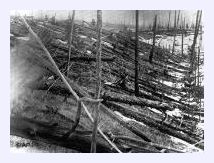
Trees lay strewn across the Siberian countryside 45 years after a meteorite struck the Earth near Tunguska, Russia in 1953
Over
the past few years however, Apophis' orbital determination has been
more finely tuned to the extent that, in October, NASA downgraded the
chance of a collision from 1 in 45,000, as previously thought, to 1 in
250,000 in 2036.
But some are still concerned. In 1908 an object with a
diameter estimated between 45 and 70 meters exploded in mid-air after
penetrating the atmosphere above Tunguska, Siberia. The blast,
estimated at 15 megatons, leveled 2,000 square miles of forest.
"If the Tunguska meteorite fell down in Europe; if it fell
down in, say, Germany, our history would be different," Valery
Menshikov, head of Roscosmos' Space Systems R&D told RT television.
"With
asteroids it's not just the probability of an impact," Michael Khan of
the ESA told Deutsche Welle. "It's also what the consequences of an
impact would be. This asteroid (Apophis) would pack a hefty punch."
"You take some of the largest nuclear bombs ever exploded,
group them together and multiply that by ten and you have approximately
the size of the explosion caused by a collision with Apophis," he said.
Tilting at asteroids
While Apophis has been a major cause for consternation since
its discovery in 2004, ESA has been drawing up plans to further study
and attempt to deflect asteroids since 2003.
The mission, dubbed Don Quijote, planned to send two
unmanned spacecraft to a candidate asteroid, one not so close to Earth
that it would pose a threat if its deflection went awry. The first
vessel, Sancho, would arrive and orbit the object, taking precise
measurements of the asteroid's orbital path for up to six months.
Then the second craft, Hidalgo, would be piloted remotely to
fly into and impact the asteroid, altering its orbit, while Sancho
maintained its observation to see how the orbit had changed. The result
of such a mission, Khan said, would be to establish whether asteroid
deflection was possible, as well as to gather essential information
about the composition of asteroids.
"If it's just a flying rubble pile it may well be that when
you hit it, it would be like ramming your fist into bag of potatoes,
moving the potatoes around but the bag would still continue on its
course," Khan said.
Lengthy timetables
Due to budget constraints ESA recently dropped the impactor
phase of the mission, but Khan is hopeful that increased international
interest could prompt one of the partners behind the mission to
reintroduce Hidalgo to the mission profile.
Don Quijote is now planned to send the Sancho spacecraft to
orbit Apophis, since there is no risk of accidentally deflecting it
towards Earth, and Khan said he anticipates a launch in 2017, barring
any problems.
Missions dealing with asteroid detection and deflection
throughout the various space agencies tend to be small, according to
Khan, and typically are not accorded the importance they deserve, a
sentiment that is echoed from Russia and the US.
One thing ESA, NASA and Roscosmos all seem to agree on is that
the research of these objects in space is an underemphasized priority,
as currently the only mitigation measures that exist would require
decades of warning to prevent catastrophe of global proportions.
Brian Vike
The Vike Factor (Into the Paranormal)
Tue, 02 Feb 2010 12:00 EST
Posted: January 31, 2010
Date: January 31, 2010
Time: Approx: 8:15 p.m.
Hi, I found your web site and thought this might interest you. There
was a strange sight that was seen over Port Glasgow tonight. At
approximately 20:15 myself and a neighbour witnessed, what appeared to
be a ball of fire moving eastwards over Port Glasgow. At one point
there looked like flames falling from this object, yet bizarrely it did
not appear to be dropping in altitude at all! Very strange indeed and
I'm sure there will be a simple explanation. Regards.
Several people reported seeing a meteor fall Monday night west of Billings in an area between Red Lodge and Molt.
Reports were vague, but the National Weather Service office in Billings
fielded a handful of calls from people who claimed to have seen the
space rock hurtling toward the Earth about 7:30 p.m.
One caller "said it lit up the sky and either burned
up just before it hit the ground or it hit the ground," NWS forecaster
Aaron Gilstead said. "It just lit up the sky with a blue light."
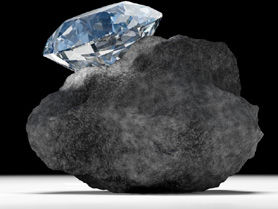
It didn't look quite this dramatic, but ultra hard diamonds were discovered in a meteorite that fell over Finland in 1971.
The
ultra hard rocks may not end up on your finger, but they could help
scientists learn how to create harder diamonds in the lab.
Researchers using a diamond paste to polish a slice of meteorite
stumbled onto something remarkable: crystals in the rock that are
harder than diamonds.
A closer look with an array of instruments revealed two
totally new kinds of naturally occurring carbon, which are harder than
the diamonds formed inside the Earth.
"The discovery was accidental but we were sure that looking in
these meteorites would lead to new findings on the carbon system," said
Tristan Ferroir of the Universite de Lyon in France.
Ferroir is the lead author of a report in the new diamond in the Feb. 15 issue of the journal Earth and Planetary Science Letters.
The researchers were polishing a slice of the carbon-rich Havero meteorite that fell to Earth in Finland in 1971.
When they then studied the polished surface they discovered
carbon-loaded spots that were raised well above the rest of the surface
- - suggesting that these areas were harder than the diamonds used in
the polishing paste.
"That in itself is not surprising," said diamond researcher Changfeng
Chen of the University of Nevada in Las Vegas. He explained that
sometimes during the shock of impact graphite can create jumbled
"amorphous" zones that can resist diamonds, at least those coming at
them from one direction.
But what apparently happened in the Havero meteorite is that
graphite layers were shocked and heated enough to create bonds between
the layers -- which is exactly how humans manufacture diamonds, Chen
explained.
Ferroir's team took the next step and put the
diamond-resistant crystals under the scrutiny of some very rigorous
mineralogical analyzing instruments to learn how its atoms are lined
up. That allowed them to confirm that they had, indeed, found a new
"phase" or polymorph of crystalline carbon as well as a type of diamond
that had been predicted to exist decades ago, but had never been found
in nature until now.
"The new structure is very interesting," Chen told Discovery
News. "It gives us some clues so we can try to make it in the
laboratory, and then investigate it."
Among the things that would be interesting to learn, Chen
said, is how hard are the new kinds of diamonds. The sample from the
meteorite was far too small to test for hardness, except to show that
it is certainly harder than regular diamonds.
"The only evidence we have for a higher hardness than diamond
is the fact that we polished the rock section with a diamond paste and
that our polymorph and polytypes were not polished by this material,"
said Ferroir. "This why we do think that its hardness is harder than
diamond."
However, there is no way at the present to compare them to the
artificial ultra-hard diamonds known as lonsdaleite and boron nitride,
Ferroir said.
WATCH VIDEO:
Find out why iron meteorites are particularly sensitive to even the
slightest bit of moisture - including the touch of a finger.
NASA's
Hubble Space Telescope has observed a mysterious X-shaped debris
pattern and trailing streamers of dust that suggest a head-on collision
between two asteroids. Astronomers have long thought the asteroid belt
is being ground down through collisions, but such a smashup has never
been seen before.
Asteroid collisions are energetic, with an average impact
speed of more than 11,000 miles per hour, or five times faster than a
rifle bullet. The comet-like object imaged by Hubble, called P/2010 A2,
was first discovered by the Lincoln Near-Earth Asteroid Research, or
LINEAR, program sky survey on Jan. 6. New Hubble images taken on Jan.
25 and 29 show a complex X-pattern of filamentary structures near the
nucleus.
"This is quite different from the smooth dust
envelopes of normal comets," said principal investigator David Jewitt
of the University of California at Los Angeles. "The filaments are made
of dust and gravel, presumably recently thrown out of the nucleus. Some
are swept back by radiation pressure from sunlight to create straight
dust streaks. Embedded in the filaments are co-moving blobs of dust
that likely originated from tiny unseen parent bodies."
Hubble shows the main nucleus of P/2010 A2 lies outside its
own halo of dust. This has never been seen before in a comet-like
object. The nucleus is estimated to be 460 feet in diameter.
Normal comets fall into the inner regions of the solar system
from icy reservoirs in the Kuiper belt and Oort cloud. As comets near
the sun and warm up, ice near the surface vaporizes and ejects material
from the solid comet nucleus via jets. But P/2010 A2 may have a
different origin. It orbits in the warm, inner regions of the asteroid
belt where its nearest neighbors are dry rocky bodies lacking volatile
materials.
This leaves open the possibility that the complex debris tail
is the result of an impact between two bodies, rather than ice simply
melting from a parent body.
"If this interpretation is correct, two small and previously
unknown asteroids recently collided, creating a shower of debris that
is being swept back into a tail from the collision site by the pressure
of sunlight," Jewitt said.
The main nucleus of P/2010 A2 would be the surviving remnant of this so-called hypervelocity collision.
"The filamentary appearance of P/2010 A2 is different from
anything seen in Hubble images of normal comets, consistent with the
action of a different process," Jewitt said. An impact origin also
would be consistent with the absence of gas in spectra recorded using
ground-based telescopes.
The asteroid belt contains abundant evidence of ancient
collisions that have shattered precursor bodies into fragments. The
orbit of P/2010 A2 is consistent with membership in the Flora asteroid
family, produced by collisional shattering more than 100 million years
ago. One fragment of that ancient smashup may have struck Earth 65
million years ago, triggering a mass extinction that wiped out the
dinosaurs. But, until now, no such asteroid-asteroid collision has been
caught "in the act."
At the time of the Hubble observations, the object was
approximately 180 million miles from the sun and 90 million miles from
Earth. The Hubble images were recorded with the new Wide Field Camera 3
(WFC3), which is capable of detecting house-sized fragments at the
distance of the asteroid belt.
Members of the public throughout the country have been reporting sightings of a fireball in the skies this evening.
Tommy Moore from Astronomy Ireland said a space rock collided with the
earth's atmosphere at about 6pm, showering debris over many parts of
the country.
Mr Moore said: "A major explosion happened in the sky over
Ireland. We think it's a fireball, that's a rock from space the earth
has slammed into and they burn up as huge shooting stars. This one
appears to have lit up the whole country. The phones here in Astronomy
Ireland are going crazy."
One man told his local radio station: "I saw the ball
of fire just above the trees. I rang the emergency services. I thought
it was a helicopter." Another said: "I thought it was a bright gas
cylinder. It seemed to get brighter as it was approaching the ground."
Alan O'Keeffe and Claire Murphy
Herald
Thu, 04 Feb 2010 10:38 EST
Show 'like something out of Armageddon'
A search was underway today for remnants of a huge fireball that lit up
the skies over north Dublin and across the country last night.
Large numbers of people reported seeing the fireball as it blazed brightly across the sky around 6pm.
Today, people living in Cavan were searching for remnants of
what is believed to have been a small asteroid, following reports it
may have hit the ground in the townland of Crimlin.
People in several parts of Dublin and around the country reported sightings of the fireball.
Today FM presenter Tim Kelly told the Herald today he saw the fireball as it seemed to streak across the sky over Dublin.
"I was visiting a friend at Dublin South FM at Dundrum and we
were five storeys up with a view over Dublin. It suddenly appeared in
the sky in the direction of O'Connell Street. It was orange with flames
coming out of it. It was like something out of the movie Armageddon.
"It seemed to be coming from the west and heading for
the north-east. It seemed the size of a 10 cent coin if you held it in
front of you with your arm outstretched."
Crimlin resident Barry Murphy said he believed the fireball
landed in his locality. It was "pure white" and it seemed to be about
two feet wide, he said.
He said it appeared to have been traveling relatively slowly
and he thought it could have landed somewhere in a field at the back of
his home. He had used lamps to search in the darkness and he hoped
today he might find some burn marks in the ground, he told RTE radio.
The fireball was "not that far up" when he saw it, he noted.
A number of other farmers in the Crimlin area said they were
searching their land this morning. Farmer Eamon Gaffney said this
morning: "I'll be having a good look around this morning. The land
around here is very rocky so it could be quite difficult to find
something that looks like a rock."
Astronomy Ireland's David Moore is appealing for people to
check footage on security cameras around 6pm, to help him get an
accurate idea of where the rock might have landed.
"It's extremely unlikely that there is footage of it
otherwise, because it lasted just one or two seconds," he said. "You
would have had to be filming at the time to get it on camera."
Mr Moore said that Astronomy Ireland has received hundreds of
emails and calls from people who saw the fireball and that staff will
process these in order to pinpoint the exact location, but all that is
known at the moment is that the fireball is believed to have landed in
the northern half of Ireland.
Mr Moore said the rock could originally have been anything
between the size of a football and a house when it originated from an
asteroid belt between Jupiter and Mars.
Valentia Coastguard said it has had reports of sightings from people living in Mullingar, Limerick, Ballybunion and Bantry.
Astronomy Ireland said there is a very rough rule of thumb that
if a fireball is brighter than the full moon then some part of it can
survive the re-entry process and land on the Earth. Such objects are
thought to be as big as say an apple. How much survives to hit the
ground depends on lots of things such as the speed of re-entry, and
whether it is made of sturdy material such as metal or light rock.
The group's website stated that an average meteor is no bigger
than a grain of sand. When it collides with the Earth the closing speed
can be of the order of 100,000mph.
A
fireball, thought to be a meteor, was spotted in the sky by people from
all over the island of Ireland at about 1800 GMT on Wednesday.
People in Armagh, Craigavon and Omagh reported sightings to the police, and it was also seen on the Glenshane Pass.
The Northern Ireland Coastguard also took calls from people who believed the fireball had landed in Lough Neagh.
In the Republic, Valentia Coastguard said it took calls about sightings in Counties Westmeath, Limerick and Cork.
'Fantastic speed'
Joss Scott was driving along the Glenshane Pass when she spotted the fireball in the sky.
"It was a very bright green, with an orange trail coming from it.
"It was traveling at fantastic speed, very high up in the sky, and it was heading north.
"It then went behind these black clouds over the Sperrins,
towards Dungiven, then there was this large orange flash, so I'm not
sure if it landed somewhere around there.
"It was quite a spectacle," she said.
Terry Moseley from the Irish Astronomical Association said such
an occurrence was "extremely rare" and said there was a chance that
some of it may have survived and fallen to earth as a meteorite.
"What it probably was is a small asteroid, which is a piece of
space rock which has collided with the earth and burned up at very high
atmosphere," he explained.
"It seems to have traveled over most of Ireland, roughly from
south to north and there is a possibility that a meteorite fell at the
end of that, possibly somewhere in County Armagh."
'Pretty unusual'
He said it was very important for anyone who saw it to report
their sighting and suggested contacting either the Armagh Observatory
or the Irish Astronomical Association.
"We'll collate all the reports, and the more reports we get, the greater the chance of us recovering some of it, if it did fall.
"It is pretty unusual that you would get one that is so widely seen, and that is so bright."
Mr Moseley said there were "only about half a dozen" recorded meteorite falls in Ireland.
"The last one was in 1999, and the last one in the North was in County Derry in 1969," he said.
Claire Bates
Mail Online
Thu, 04 Feb 2010 19:05 EST
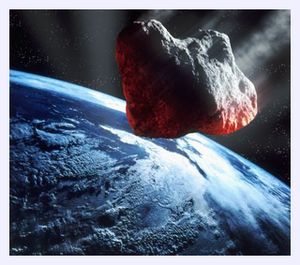
A veil of dust thrown up by an asteroid 2,000ft across may have caused a mini ice-age in 535AD
In the mid-sixth century, Europe and Asia experienced the most severe and protracted episode of cooling of the last 2,000 years.
Sources from the time refer to widespread crop failures and famines as the unseasonal weather took hold. The Gaelic Irish Annals recorded 'a failure of bread' from 536 to 539AD.
Tree ring analysis by Mike Baillie from Queen's University in Belfast
also suggested a cool period. He found the Irish oak showed abnormally
little growth in 536 and 542. This phenomenon was noted in trees in
Sweden and Finland as well.
The cause, according to historic sources, was a huge dust veil that descended on Earth.
For instance Byzantine historian Procopius recorded in 536AD that
'during this year a most dread portent took place. For the sun gave
forth its light without brightness.
'It seemed exceedingly like the sun in eclipse, for the beams it shed were not clear.'
Until now scientists were divided as to whether the dust cloud
was caused by a huge volcanic eruption like Krakatoa or a meteorite
slamming into Earth.
The eruption theory has many supporters due to sulphate deposits found in ice cores from that period.
However, Dr Abbott's research suggests the alternative theory.
She found satellite measurements of sea levels pointed to two
significant craters off Australia, which were 11miles and 7.4miles
wide.
According to National Geographic, she was led to the
site by large v-shaped dunes along the coast, which she believes are
evidence of a great tsunami triggered by a giant impact.
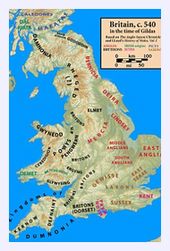
Britain
was divided into a number of warring kingdoms in the 6th century.
Sutton Hoo was first used as a burial site at this time
Dr
Abbott calculated that the original object must have been 2,000ft
across. She also found that core samples from the area revealed
material likely to have been melted and then blasted into the sky.
This could fit quite neatly with a 2004 paper in the journal of Astronomy and Geophysics, which suggested an object around 2,000ft across could have caused a cooling event on the scale of AD535.
Other researchers led by U.S. physicist Mark Boslough have dismissed Dr Abbott's theory.
Dr Boslough said if a large impactor had broken up as it
approached Earth's surface, the fragments should have 'essentially
behaved as one piece', creating just one crater.
He added that Dr Abbott and others had found 'evidence' of more impact events than astronomer's believe are possible.
Dr Abbott has staunchly defended her work. While she agreed her
case wasn't 100 per cent proven she said: 'I think we're getting very
close to being able to show there were a lot of impacts in the last
10,000 years.'
Richard A. Lovett
National Geographic News
Wed, 03 Feb 2010 11:04 EST

An asteroid hurtles toward Earth in an artist's rendering.
Double impact may have caused tsunami, global cooling
Pieces of a giant asteroid or comet that broke apart over Earth may have crashed off Australia about 1,500 years ago, says a scientist who has found evidence of the possible impact craters.
Satellite measurements of the Gulf of Carpentaria (see map)
revealed tiny changes in sea level that are signs of impact craters on
the seabed below, according to new research by marine geophysicist
Dallas Abbott.
Based on the satellite data, one crater should be about 11
miles (18 kilometers) wide, while the other should be 7.4 miles (12
kilometers) wide.
For years Abbott, of Columbia University's Lamont-Doherty Earth Observatory, has argued that V-shaped sand dunes along the gulf coast are evidence of a tsunami triggered by an impact.
"These dunes are like arrows that point toward their source,"
Abbott said. In this case, the dunes converge on a single point in the
gulf - the same spot where Abbott found the two sea-surface
depressions.
The new work is the latest among several clues linking a major
impact event to an episode of global cooling that affected crop
harvests from A.D. 536 to 545, Abbott contends.
According to the theory, material thrown high into the
atmosphere by the Carpentaria strike probably triggered the cooling,
which has been pinpointed in tree-ring data from Asia and Europe.
What's more, around the same time the Roman Empire was falling
apart in Europe, Aborigines in Australia may have witnessed and
recorded the double impact, she said.
Aborigine Eyewitnesses
Based on the new research, Abbott thinks the two craters were made by an object that split into pieces as it approached Earth.
To make a pair of craters this big in the seafloor's soft sediments,
the original object must have been about 2,000 feet (600 meters) across
before it broke up, she said.
Core samples from the region back up the case for such an
impact, Abbott added. Previous research had found that the samples
contain smooth, magnetic spherules, which were probably created when
the object's explosive landing melted material and blasted it into the
sky.
Furthermore, a 2004 paper in the journal Astronomy and Geophysics
suggested that the circa-A.D. 500 global cooling event might have been
caused by dust from an impact of approximately the size Abbott has now
calculated for Carpentaria.
It's even possible the impact had eyewitnesses: Aboriginal
rock art from the region seems to have recorded the event, although the
researchers examining this art declined to discuss details until after
their paper has been published.
Still, Duane Hamacher,
a Ph.D. student at Macquarie University in Sydney not involved with the
rock-art work, recently demonstrated that Aboriginal stories can be
used to locate meteorite craters.
"Numerous examples of fiery stars falling from the sky and
striking the earth, causing death and destruction, are found throughout
Aboriginal Dreamings [spiritual folk stories] across Australia,"
Hamacher wrote on his blog.
"The descriptions seem to indicate that the events were witnessed, not simply 'made-up.'"
In findings yet to be published, Hamacher used one set of
Aboriginal stories, along with images in Google Earth, to locate a
919-foot-wide (280-meter-wide) impact crater in Palm Valley, in
Australia's Northern Territory.
Too Many Meteorite Strikes?
But some experts are skeptical of Abbott's conclusions, which were presented last December at a meeting of the American Geophysical Union in San Francisco.
One potential problem is the presence of two separate craters at the Gulf of Carpentaria site, said physicist Mark Boslough of Sandia National Laboratories in Albuquerque, New Mexico.
If a large impactor had broken up on its final approach to Earth, he
said, the fragments would still have been very, very close together
when they landed: "It essentially will behave as one piece," creating a
single crater, Boslough said.
In addition, he said, Abbott and other members of an informal association called the Holocene Impact Working Group are finding evidence for more impact events than astronomers calculate should be possible.
Abbott and colleagues argue that several climate events during
the Holocene epoch - 11,500 years ago to the present - were actually
triggered by impacts, and therefore such large impacts are more common
than currently believed.
Boslough and other experts, meanwhile, have been cataloging
asteroids and other bodies that cross Earth's orbit and calculating how
frequently space rocks should strike the planet.
"We have a pretty good idea about how many there are and what
the frequency of impact should be, and the abundances based on [the
working group's claimed crater count] are orders of magnitude greater
than what astronomers observe," Boslough said.
"It's pretty hard to imagine where these things could be coming from so that astronomers wouldn't see them."
Instead, it's more likely that the craters found by the working group have volcanic origins, the impact skeptics conclude.
Abbott acknowledges that her case for Carpentaria isn't
100-percent proven. But in general, she said, "I think we're getting
very close to being able to show there were a lot of impacts in the
last 10,000 years."
Comment: For an in-depth study, read Laura Knight-Jadczyk's review of New Light on the Black Death: The Cosmic Connection.
Boulder Weekly / McClatchy-Tribune News Service
Fri, 05 Feb 2010 20:14 EST

Is this mystery object a comet or the result of an asteroid collision?
An object imaged last week by the Hubble Space
Telescope looks at first glance to be a comet, but a closer examination
indicates it is something researchers have never seen before - the
immediate aftermath of two asteroids colliding.
The scattered debris that looks like a comet's tail is
actually the result of two asteroids colliding nearly head-on at more
than 11,000 miles per hour, scattering pieces in all directions, NASA
announced earlier this week. The asteroid belt between Mars and
Jupiter, where the collision occurred, contains the remains of many
such events from the distant past, but this is first time that
researchers have observed such debris so soon after a collision.
The object, called P/2010 A2, was first observed Jan. 6 by the
Lincoln Near-Earth Asteroid Research program, and astronomers thought
it was a comet. But images taken by Hubble on Jan. 25 and 29 show
something far different.
Comets are icy bodies that fall into the inner solar system
from distant reservoirs in the Kuiper Belt and Oort Cloud. As they warm
up, they shed particles and water vapor that are pushed away from the
comet in a smooth tail by solar pressure.
But spectra of P/2010 A2 show no gases associated with
the object, indicating there is no water present. The main body of the
object, which is about 460 feet in diameter, lies separate from the
"tail," and the tail itself shows an unusual filamentous structure that
includes a large X-shaped portion.
The most likely explanation, said principal investigator David
Jewitt of the University of California Los Angeles, is that two small
and previously unknown
asteroids recently collided, creating a shower of debris that is being
swept back into a tail from the collision site by the presence of
sunlight.
Based on the length of the tail, about 100,000 miles, the collision probably happened just a few months ago, Jewitt said.
The orbit of the object suggests that it is part of the Flora
asteroid family, a group produced by other collisions more than 100
million years ago. One former member of the family is thought to be the
asteroid that struck Earth 65 million years ago, creating a global
cooling that caused dinosaurs to become extinct.
When observed by Hubble, P/2010 A2 was about 180 million miles from the sun and 90 million miles from Earth.
In addition to the image being "a super-cool thing to look at,"
Jewitt said, "it will help us understand the physics of the breakup of
a body in space. That's almost unexplored, but it is something we want
to know about" because of the likelihood that a large asteroid will
eventually approach Earth and need to be destroyed.
Comment: For a closer look at meteorites, asteroids and comets read Laura Knight-Jadczyk's Meteorites, Asteroids, and Comets: Damages, Disasters, Injuries, Deaths, and Very Close Calls.
Brian Vike
The Vike Factor (Into the Paranormal)
Fri, 05 Feb 2010 10:33 EST
Posted: February 4, 2010
Date: February 3, 2010
Time: Approx: 7:15 p.m.
Hi. I found your website on Google. Last night (Feb 3) at approximately
7:15pm my husband and I were traveling west on California highway 118
coming into Simi Valley. Just northwest of our car up in the night sky,
I spotted a bright light that at first looked like a small plane. It
was very bright yellow/white and formed an arc as it traveled with a
bright blue-green ball as the center. It lasted only several seconds,
but it was very noticeable.
Did you have any reports of such an object in the sky?
I presume it to be a meteor. But since I have never seen anything like
this in my 54 years, I am not sure.
Thanks.
A UFO researcher and author from Finland calls it "the December Phenomenon."
Bjorn Borg, a 63-year-old retired economist, says each winter he can
count on media reports of what appear to be rocket or missile sightings
of the kind seen last week over Newfoundland's south coast.
"Every year this comes up in the news," he said Monday from Helsinki.
But what people are really seeing is the effect of jetliner vapour trails catching winter sunlight, he said.
Borg studied photos taken at sunset a week ago in Harbour
Mille, N.L., by resident Darlene Stewart. He believes what she and two
others witnessed was nothing more than the optical illusion created
when setting sun hits a jetliner at just the right angle.
"The sun is shining on the (condensation) trail. In winter
time, the colour of the trail will show up (in) very strong yellow or
even red. It looks like fire."
Borg said he has documented the same phenomenon more than 20 times around the world in recent years.
His theory was backed up Monday by Chris Stevenson, local president of the Royal Astronomical Society.
"It's unbelievable how far this went," Stevenson said of rampant
speculation about covert foreign missile testing or perhaps alien life
forms.
"I've seen this several times," he said of the effect created
when transatlantic aircraft, which often travel in pairs, reflect
sunlight far overhead after daylight has faded on the ground.
The resulting bursts of colour can be spectacular and startling, Stevenson said.
"They might strike fear in the hearts of people who don't know what they're looking at."
Stewart's photo is obviously not a rocket because the contrail goes transparent at the end, Stevenson said.
"A rocket plume would be thick all the way back to where the
rocket was launched. Again, had the sighting not been at sunset, I
would have taken this a bit more seriously."
Still, Stewart is adamant that what she captured on her digital camera was no jetliner.
"To me, it was not a jet," she said from her home Monday in Harbour Mille. "No, no, no.
"We didn't hear any noise. No noise. Every airplane that comes
over here, whether we're inside or the TV's going, you still hear them.
A jet may be farther off but it still makes noise.
"To me and my eyes, it was not a jet."
The federal government had little to say Monday.
"There is no indication that there was ever a rocket launch,"
said Public Safety spokesman Chris McCluskey before declining further
comment. He suggested other queries be put to Defence Department, which
had no immediate response.
The RCMP deferred to Public Safety.
Newfoundland and Labrador Premier Danny Williams said Friday
that he, too, had heard suggestions that the sightings may have been
reflected aircraft.
He said he believed Prime Minister Stephen Harper and Defence
Minister Peter MacKay when they told him there was no evidence of any
missile launch -- foreign or otherwise.
"They've checked everything within the defence systems," Williams said.
"Something was seen. But from a Canadian defence perspective,
I'm satisfied ... that there certainly wasn't anything that was being
hidden by the government of Canada."
Source: The Canadian Press
Andy Mannion
UK UFO Sighting Reports
Sat, 06 Feb 2010 10:42 EST
Posted: February 5, 2010
Location of Sighting: Timperley, South Manchester
Date of Sighting: 31st January 2010
Time: 18:23
Witness Statement: While playing with my
dog in the back garden I pointed my torch at the roof next door and
when I looked up I saw what was an orange ball in the sky.
Now I know your saying chinese lanterns but this was no chinese lantern.
The object was moving relatively fast I'd say it traveled
towards Center of Manchester (about 8 miles in 2mins) but had an orange
aura around it as well as a tail. My first thought was definitely
chinese lantern but it was impossible at the rate it was traveling. The
tail was obvious as it was quite far behind the object as well as an
orange glow at the front end of where it was traveling.
Just out of curiosity wondered what it was as I checked online and couldn't find anything online about it.
Andy Mannion
UK UFO Sighting Reports
Sat, 06 Feb 2010 11:30 EST
Posted: February 5, 2010
Location of Sighting: Rothwell, Northamptonshire
Date of Sighting: 5th Feb 2010
Time: 21:00 hrs
Witness Statement: I would like to report
a sighting of a fireball over my home in Rothwell Northamptonshire, I
spotted this fireball around 21:00 hrs on the 5th Feb 2010. It was
heading North but not sure how fast it was traveling I would say around
300mph as it looked as if it was traveling at the same speed as a plane
would go. I tried to get video footage but by the time I got to my
phone the fireball was going out of sight, managed to get a couple of
seconds but it not brilliant.
I told my family but didn't think too much of it, but
then when I looked on the internet to see if anyone else had seen it I
came across a news article about one being spotted in Ireland.
Sun, 07 Feb 2010 08:45 EST
Press Trust India
New Delhi - Geologists appear to have stumbled upon a meteorite-hit
site in western Rajasthan after they discovered quartz-like mineral
that is similar to the one found near the famous Lonar crater lake in
Maharashtra. The experts from the Indian Institute of Technology-
Bombay detected occurrence of stishovite mineral in magnetic particles found in MokalsarSiwana way of the Siwana volcanic province in western Rajasthan.
"Such magnetic spherules, with 57 per cent of magnetite and 37 per cent
haematite and with insignificant rare earth element (REE) content have
been reported recently from a wide variety of geological formations and
Recent Alluvium," Prof D Chandrashekhram of IIT-Bombay told PTI over
phone. The stishovite discovered
in the Siwana volcanic province of western Rajasthan is somewhat
similar to the Lonar crater and formed by a series of meteor or
asteroid impact, he said.
The structure has huge rings which the experts say
makes it geologically unusual in the terrains of Rajasthan. "There is a
huge ring structure in the stishovite which we call the Siwana rings and has been formed due to meteoric impact," he said.
These Siwana rings are "unique" in terms of geographic location,
geological relations in the vicinity of the structure, distinctive
shape and surface sculptures, Chandrashekaram said.
Lynda La Rocca
The Pueblo Chieftain
Sun, 07 Feb 2010 12:01 EST
Arizona
- OK, I admit it. The main attraction at Meteor Crater Natural Landmark
really does look like a great big hole in the ground.
But looks, as they say, can be deceiving.
Some 50,000 years ago, a meteorite slammed into this wind-swept
plateau, spewing molten fragments over the surrounding landscape and
creating the world's best-preserved, and first scientifically
authenticated, meteorite impact crater.
Standing on one of the crater's four outdoor observation
platforms, it's difficult to imagine how a rock could have gouged out
this gaping, bowl-shaped depression that measures more than 4,000 feet
across and is deeper than a 60-story building is tall.
But then we're talking about a chunk of iron that
weighed 330,000 tons, traveled at an estimated 40,000 mph - a speed
that would have propelled it across the entire continental United
States in about four minutes - and crashed to Earth with the explosive
force of approximately 20 million tons of TNT. The Canyon Diablo
meteorite, as it's called, was originally part of an asteroid. These
small, celestial "leftovers" from the formation of the solar system are
primarily located in an area of interplanetary space between the orbits
of Mars and Jupiter. A half-billion years ago, some sort of
otherworldly collision shattered this particular asteroid, hurling part
of it into space, where it cruised around harmlessly for eons before
crossing paths with our world.
Despite melting, disintegrating and partially vaporizing upon
impact, the Canyon Diablo meteorite still left behind enough of itself
- more than 15 tons have been recovered, with some fragments scattered
as far as 6 miles from the crater's center - for scientists to
categorize it as an iron meteorite. One of three types of meteorites
(the other two are called stony and stony-iron), the Canyon Diablo
meteorite is composed of 92 percent iron and 7.1 percent nickel, along
with traces of such rare metallic elements as gallium, iridium and
germanium.
Visitors can actually touch the largest piece of the Canyon
Diablo meteorite found to date, a pockmarked, silvery-black,
1,406-pound space rock called the Holsinger meteorite in honor of
discoverer S.F. Holsinger, an early explorer of the crater. This
meteorite is on display at the adjoining Meteor Crater Museum and
Interactive Learning Center, which houses, in addition to its
impressive meteorite collection, an 80-seat, wide-screen theater
featuring the short film "Collisions and Impacts," along with more than
two dozen interpretive, hands-on and interactive displays. Topics range
from the history and geology of Meteor Crater to Comet Shoemaker-Levy
9, which crashed into the planet Jupiter in 1994, and the ongoing
search by Flagstaff's Lowell Observatory for "near-Earth objects,"
celestial bodies that could conceivably pose a threat to our planet.
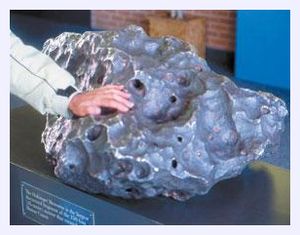
Visitors are invited to touch the 1,406-pound Holsinger meteorite at Meteor Crater Natural Landmark.
My
husband Steve and I are engrossed by exhibits that enable us to compare
the magnetism of highly magnetic iron meteorites like Canyon Diablo
with that of stony meteorites, which primarily consist of non-metallic
minerals called silicates and therefore exhibit very little magnetism.
Then we "Create a Crater," using a computer to select a meteor size,
type and density and observing the results after setting our virtual
creation on a collision course with a specific target.
A video magnifier enables us to examine the differences
between rocks formed under normal Earth temperatures and pressures and
rocks that have been moderately to severely "shocked." Shocked rocks
have been exposed to explosive forces like that generated by an atomic
blast - or a meteorite impact. This subjects the rocks to temperatures
and pressures high enough to alter their crystalline structure,
sometimes into forms that do not occur naturally on Earth.
We even step inside the "Put Yourself at Ground Zero" exhibit
to get a sense of what it might have felt like in the impact zone when
the Canyon Diablo meteorite hit - minus, fortunately, the sensations of
being instantly vaporized by clouds of dense, super-heated gas or
crushed by the 175 million tons of sandstone and limestone that were
displaced by the collision and explosion. Some of this debris forms the
rim of Meteor Crater, which rises 150 feet above the otherwise flat
plain. And when snowfall cancels this day's regularly scheduled, guided
walking tours of a portion of the crater rim, we spend extra time at
the site's Astronaut Park picnic area, where we peer inside a 1965
Apollo test capsule and peruse the American Astronaut Wall of Fame
commemorating astronauts from the Mercury, Gemini and Apollo space
programs.
Because of its resemblance to lunar-surface impact craters,
the National Aeronautics and Space Administration (NASA) used Meteor
Crater as a training site for its Apollo-program astronauts. Designed
to land humans on the moon and bring them safely back to Earth, the
Apollo program achieved that goal six times between July 1969, when the
crew of Apollo 11 made mankind's first lunar landing, and the final
Apollo moon mission in December 1972.
The late Dr. Eugene M. Shoemaker, co-discoverer of Comet Shoemaker-Levy
9, helped train the Apollo astronauts at Meteor Crater. Shoemaker, who
wrote his doctoral thesis on the crater, was renowned for his work on
extraterrestrial impacts and the mechanics of meteorite impacts, and
for his co-discovery of coesite, a shocked form of quartz rarely found
naturally on Earth.
The floor of Meteor Crater has been partially filled by
centuries of accumulated rock and debris from its original, post-impact
depth of 700 feet to its current depth of just over 550 feet. The floor
is considered a scientific laboratory, making it off-limits to the
general public.
Hollywood has had better luck gaining access to it.
Several movies have been filmed here, including the 1984
classic "Starman," in which a celestial voyager played by actor Jeff
Bridges rendezvoused with the mother ship at Meteor Crater.
Heck, if I were an alien (and some might question my use of
the word "if"), I'd also want to blast off from Meteor Crater. It would
make a great starting point for what would certainly be one long,
strange trip.
Another name
Meteor Crater, the main attraction at Meteor Crater Natural
Landmark, is also known in scientific circles as the Barringer Meteor
Crater. It is named after Daniel Moreau Barringer, a Philadelphia
mining engineer and lawyer who correctly identified the crater's impact
origin more than a century ago.
UFOs Northwest
Mon, 08 Feb 2010 14:23 EST
Posted: February 7, 2010
Date of Sighting: February 6, 2010
Time of Sighting: 10:55 PM EST
Location of Sighting: Suitland, Maryland (Near Washington, D.C.)
Description: On the night of February 6,
2010 at 10:55 PM I looked out my window in Suitland, Maryland and saw a
large white ball with a long tail on it flying across the sky.
Note: Probable meteor.
Randy Boswell
Canwest News Service
Mon, 08 Feb 2010 00:17 EST
One of Canada's top archeologists argues in a new book that the
prehistoric ancestors of this country's 55,000 Inuit probably migrated
rapidly from Alaska clear across the Canadian North in just a few years
- not gradually over centuries as traditionally assumed - after they
learned about a rich supply of iron from a massive meteorite strike on
Greenland's west coast.
The startling theory, tentatively floated two decades ago by
Canadian Museum of Civilization curator emeritus Robert McGhee, has
been bolstered by recent research indicating a later and faster
migration of the ancient Thule Inuit across North America's polar
frontier than previously believed.
Now, in a just-published volume of essays by some of the
world's leading Arctic archeologists, McGhee advances his theory - a
4,000-kilometre beeline quest for iron from Greenland's famous Cape
York meteorite deposit - as the likeliest explanation for the sudden
spread of the Thule culture across Canada around 1250 AD.
"Current evidence increasingly suggests that the
concept of a relatively slow, environmentally driven Thule Inuit
expansion across Arctic Canada, beginning around AD 1000, is no longer
viable," McGhee writes in The Northern World: AD 900 to 1400, a newly
released book he co-edited with two U.S. scholars.
Instead, he argues, new radiocarbon data and other
reassessments of Eastern Arctic archeological sites suggest the
Alaska-based Thule undertook an epic voyage by skin boat and dogsled -
almost directly from Alaska to Greenland, and within a few summer
travelling seasons - about 750 years ago.
Significantly, Thule Inuit archeological sites near the Cape
York deposits are older than others in Canada closer to Alaska -
further suggesting an initial dash to the northeast Arctic followed by
a more gradual dispersal of population groups throughout present-day
Nunavut, Northwest Territories and Yukon.
McGhee believes the Thule Inuit had learned about the valuable
metal at the Cape York meteorite field from contact with Canada's
aboriginal Dorset people, who were already using iron and trading it
with Norse sailors from southern Greenland and Iceland.
"It would seem plausible to suggest that metal - meteoric iron
from the Cape York meteorites and metal goods traded from the Norse -
may have been the magnet that drew ancestral Inuit eastward from
Alaska," McGhee contends.
He adds that this interpretation of Inuit origins in Canada -
as resulting from "commercial motives" and "mercantile exploration" -
challenges the prevailing view that ancient native cultures would only
migrate to new territories incrementally and in response to
environmental pressures, dwindling food supplies or competition from
rival peoples.
"We may have been led astray by the deeply rooted
archeological tendency to ascribe different sets of motives and
different cultural processes to aboriginal peoples than we apply to
Europeans or other societies with a written record of individual
accomplishment," McGhee concludes. "Future archeological work may
indicate that ancestral Inuit may be more accurately viewed as an
entrepreneurial people" driven by the same kinds of economic
opportunities that prompted such explorers as Christopher Columbus,
John Cabot and Jacques Cartier to sail for the New World centuries
later.
McGhee, who lives near Ottawa, told Canwest News Service on
Monday that the Thule Inuit used iron for weapon points but also to
carve the antler and bone implements central to their technology and
culture.
The apparent target of the Thule Inuit's suspected race for
Arctic resources - reminiscent of the current "rush" for polar oil by
Canada and the four other Arctic coastal states - was the series of
enormous nickel-iron space rocks that crashed to Earth in northwestern
Greenland unknown millennia ago.
The Dorset people - a "paleo-Eskimo" culture that disappeared
from the Canadian Arctic when the Thule Inuit arrived - are known from
archeological investigations to have used Cape York meteoric iron for
centuries.
But it wasn't until the 1890s that U.S. Arctic explorer Robert
Peary first documented the meteorites and arranged for the transport of
several large specimens to the American Museum of Natural History in
New York, where they are still on display.
Another enormous Cape York meteorite was shipped to Denmark,
which governs Greenland, and can be seen today outside a geological
museum in Copenhagen.
Andy Mannion
UK UFO Sighting Reports
Tue, 09 Feb 2010 11:08 EST
Posted: February 8, 2010
Location of Sighting: llandysul, ceredigion
Date of Sighting: 7th feb 2010
Time: approx 11pm
Witness Statement: Whilst standing
outside in the back yard we both looked up to try and make some sense
of what appeared to be 2 fire balls traveling through the night sky in
complete silence, it was spooky. I ran in to check the local news but
couldn't find any details mentioning the sighting. In the meantime my
partner had witnessed a third ball of flames go past. They appeared
very equal in distance between each other and to be traveling an
identical silent course. These were NOT lanterns...meteors?
Nuala McAloon
The Fermanagh Herald
Tue, 09 Feb 2010 22:48 EST
Mystery still surrounds the reported sighting of what is thought to
have been a meteor in south Fermanagh. One witness described seeing a
'fireball' lighting up the sky near Teemore last Wednesday evening -
around the time that a number of similar sightings were reported in
neighbouring counties in the northern half of the country.
It is the first time in 40 years that such a sighting has been
made in Ireland, with only about half a dozen recorded meteorite falls
in the country altogether.
The last one was in 1999, and the last one in the North was in Derry in 1969. One lady from Teemore told the Herald:
"It was about 6.15pm on Wednesday evening and it wasn't fully dark. I
saw the fireball from a window in the living room. It dropped a few
miles from the house I'd say. At first I thought it was a small
helicopter but it was more like a rocket or a flame gliding through the
sky and then it disappeared into the fields a couple of miles from here
in Teemore. There was no smoke or anything so I knew that nothing had
crashed. It was just so unusual and it was not a rocket or a firework.
It must have been about 12 to 18 inches in size."
According to the Irish Astronomical Association, the
fireball was seen in a number of counties including Tyrone, Donegal and
Sligo.
"There were two separate events," a spokesman said. "The
first, and almost certainly the most important, was at about 5.50pm,
and seems to have travelled from Kerry at least as far as Armagh and
south Tyrone. That one may have been a 'meteorite dropper', though it's
too early to say.
"The second, not as big or bright, but at least as bright as
Venus, was at about 7.30 - 7.40pm more than one and a half hours later.
It was seen from near Moy, Co Tyrone, and was travelling in a north
east direction."
Terry Moseley from the IAA said such an occurrence was
extremely rare and said there was a chance that some of the asteroid
may have survived and fallen to earth as a meteorite.
"What it probably was is a small asteroid, which is a piece of
space rock which has collided with the earth and burned up at a very
high atmosphere.
"It seems to have travelled over most of Ireland, roughly from
south to north and there is a possibility that a meteorite fell at the
end of that, possibly somewhere in Armagh."
He said it was very important for anyone who saw it to report
their sighting and suggested contacting either the Armagh Observatory
or the IAA.
"We'll collate all the reports, and the more reports we get,
the greater the chance of us recovering some of it, if it did fall. It
is pretty unusual that you would get one that is so widely seen and is
so bright."
Anthony Kovats
Quebec Media Inc. Agency
Thu, 11 Feb 2010 02:23 EST
We are never alone. As mankind continues to plod its way into the
stars, it's sometimes easy to forget that heavenly bodies, which blaze
across the night's sky only to hammer into the earth, constantly visit
us.
These visitors are meteors, the stuff of legend, fear and even faith among ancient peoples.
And those violent visits still speak to us today, not through
mysticism or legend, but through science. After all, we are dealing
with an extraterrestria - an untold billion-year-old chunk of rock that
has been hurtling through untold reaches of space.
Amateur astronomer and author Anthony Whyte says that the
exploration of space begins in our own backyard. It's an epic mystery
that can fill in the missing pieces of our past and tell how the
landscape was, and is, forever changed by each impact.
His new book, The Meteorites of Alberta, is a
journey that delves into the history of this province and the explorers
who are still peeling away the legends to find the facts.
"The more I read about this, the more and more interesting
tales I discovered. I said '... it's a shame this stuff isn't more
widely known."
Meteorites have always been a fascination for Whyte.
He's been a member of the Royal Astronomical Society of Canada for more
than three decades and even met his wife through the society, but his
interest really piqued about 12 years ago, when helping his daughter
with a school science project.
To lend authenticity to her project and to breathe some life
into dusty research papers that Whyte admits he voraciously digests, he
took his daughter into the field. What better classroom is there?
The destination was Alberta's Badlands and the search for the
legendary K-T Boundary, a thin crust of sedimentary rock separating two
very distinct periods in history: the end of the Mesozoic era, and the
rebirth of the planet, the Cenozoic era, after years of darkness - in
short, the big meteorite many scientists suggest pummeled the earth and
the ensuing dust cloud and fallout of dust and debris that blocked out
any sunlight wiping life of the proverbial map. . . the end of the
dinosaur.
Whyte and his daughter hunted through the Badlands, and while
not as easy as he first thought, the father and daughter team did find
an example of Alvarez' K-T discovery, the thin anomaly separating
millions of years of history.
From that expedition, Whyte realized that Alberta is rich in
meteorites and he cites examples like the 1,100-year-old crater near
Whitecourt; finds near Ferintosh, Vulcan, Kinsella, Mayerthorpe,
Bruderheim; the nationally acclaimed Edmonton meteorite to the almost
mystical Iron Creek meteor. The list is endless.
But none of this is new. Meteor hunters have been scouring the
province for nigh a century and have gone to great lengths to find
these extraterrestrials, even plumbing the depths of Lake Wabamun or
slogging through countless square kilometres of bogs and forest on a
hunch of a reported sighting.
The '60s were a golden decade in Alberta's meteor hunting
history. No fewer than seven were found in an eight-year span, a record
unequalled in Canada until the 21 Century.
"This is exciting stuff, but it's not widely disseminated so
hopefully my book makes it more widely known,," said Whyte. But what he
may not have realized even as he penned the book, is that it really is
a traveler's field guide.
A meteorite has smashed into the ground in Mexico, leaving a 30 meter (100 feet) wide crater, reports said.
The meteorite impact was in the Ahuazotepec Municipality in Central Mexico between the cities of Puebla and Hidalgo.
The precise impact area of the meteorite was in a relatively
unpopulated area and hit around 6.30pm local time, Mexican media said.
The Ahuazotepec, Mexico meteorite impact was so massive it
broke windows in homes many kilometers from the epicenter and people
reported buildings swaying and mass confusion. Other reports said the
Mexico meteorite impact partially damaged a road and a bridge.
The Mexican military was called in to lock down the area where the apparent space rock slammed into the ground.
Initial fears where that the impact was a aircraft crashing to the ground, but that report was later dismissed.
The Central Mexico meteorite event was witnessed by countless people in
the region of the impact, with people as far away as Mexico City saying
they saw the burning object enter the atmosphere.
The Times of India
Fri, 12 Feb 2010 05:41 EST
Panaji/Marago - - A series of mysterious blasts that were heard but not
seen had South Goa in a tizzy and sparked off speculation about the
nature and origin of the explosions on Thursday. Sources said the
blasts occurred thrice in succession at around 12:30pm and the origin
could be somewhere in Goa's southernmost taluka of Canacona.
The meteorology department in Panaji noted the "disturbance"
on its seismograph but said it could not determine its direction or
origin.
Quepem sub-divisional police officer R K Patre said he scouted
various beach stretches in Canacona, but could not find any trace of a
blast. Patre said he also got in touch with the police in Karwar and
was told that they too had heard the bang. It is learnt that the noise
thundered in Cuncolim and some even in Navelim and Colva claim to have
heard it.
A few houses in Mudgeri and Bawal villages of Karwar,
near Goa's southern border with Karnataka, were reported to have
suffered damage following the "blasts". Reports reaching Panaji said
some fishermen from Karwar had seen an aircraft drop something in the
sea around noon.
Navy officials in New Delhi denied there was any exercise in
the area. Vasco-based navy PRO M C Joshi also denied that any
experiments.
"Indian Navy always gives warning to fishermen and mariners
before doing any tests so that mariners are well clear of the area," he
said.
Confirming the "disturbance", meteorology department director
K V Singh said, "There was no tremor, but there were some recurring
disturbances like some blast noises. It was not just once, but a number
of times. It is, however, difficult to analyze them." He said such
disturbances are recorded daily and they vary, but on Thursday, within
an hour, there was a series of sounds, after about every five minutes.
The meteorology department in Panaji recorded 'disturbances'
caused by a mysterious 'blast' on Thursday. ''However, the direction
and distance cannot be analyzed, but these are not earthquakes,'' met
director K V Singh said. Two of the three components--east-west
component and north-south component-indicate the distance and origin of
sound, but the seismograph showed only the Zcomponent-disturbance.
Coast guard officials said the crew on their vessel cruising
about four miles in the area between Karwar and Canacona did not hear
any sound.
Coast guard DIG M S Dangui said, ''Our men did not hear any
sound. Local fishermen said nothing happened, but that they heard some
loud sounds.''
Stating that they have ruled out that it was from a ship,
Dangui said the coast guard had received information around 1.30pm
regarding the blast-like sounds. ''The coast guard ship C 133 was in
the area for three hours, but could not discover anything,'' he said.
Efforts to contact the naval base Sea Bird proved futile.

The
red smudge at the center of this picture is the first comet discovered
by NASA's Wide-Field Infrared Survey Explorer, or WISE.
The
Wide-field Infrared Survey Explorer or WISE is living up to
expectations, as it now has discovered its first comet, shortly after finding its first asteroid.
The spacecraft, just launched on Dec. 14, 2009 and first spotted the
comet on January 22, 2010. WISE is expected to find millions of other
objects during its ongoing survey of the whole sky in infrared light.
Officially named "P/2010 B2 (WISE)," the comet is a dusty mass of ice
more than 2 kilometers (1.2 miles) in diameter.
Comet and asteroid hunter Robert Holmes, who we have written about previously on Universe Today
(whose Astronomical Research Observatory and Killer Asteroid Project in
Illinois is not far from where I live) made the first ground-based
confirmation of WISE's comet discovery, with his home-built 0.81-meter
telescope. Many large observatories attempted to confirm this discovery
more than 7 days earlier including the Faulkes 2.0m telescope in
Hawaii, without success. And due to poor weather, Holmes had to wait
several days to get a look at the WISE comet himself. Holmes produces
images for educational and public outreach programs like the
International Astronomical Search Collaboration (IASC), which gives
students and teachers the opportunity to make observations and
discoveries, and a teacher actually assisted in the confirmation of
this new comet.
Astronomers from the WISE team say the comet probably
formed around the same time as our solar system, about 4.5 billion
years ago. Comet WISE started out in the cold, dark reaches of our
solar system, but after a long history of getting knocked around by the
gravitational forces of Jupiter, it settled into an orbit much closer
to the sun. Right now, the comet is heading away from the sun and is
about 175 million kilometers (109 million miles) from Earth.
"Comets are ancient reservoirs of water. They are one of the
few places besides Earth in the inner solar system where water is known
to exist," said Amy Mainzer of NASA's Jet Propulsion Laboratory in
Pasadena, Calif. Mainzer is the principal investigator of NEOWISE, a
project to find and catalog new asteroids and comets spotted by WISE
(the acronym combines WISE with NEO, the shorthand for near-Earth
object).
"With WISE, we have a powerful tool to find new comets and learn more
about the population as a whole," said Mainzer. "Water is necessary for
life as we know it, and comets can tell us more about how much there is
in our solar system."
"It is very unlikely that a comet will hit Earth," said James
Bauer, a scientist at JPL working on the WISE project, "But, in the
rare chance that one did, it could be dangerous. The new discoveries
from WISE will give us more precise statistics about the probability of
such an event, and how powerful an impact it might yield."
Comet WISE takes 4.7 years to circle the sun, with its
farthest point being about 4 astronomical units away, and its closest
point being 1.6 astronomical units (near the orbit of Mars). An
astronomical unit is the distance between Earth and the sun. Heat from
the sun causes gas and dust to blow off the comet, resulting in a dusty
coma, or shell, and a tail.
Prof.
Ana Luisa Cid, following up on developments in the story of the
"Hidalgo Crash", informed us today at 3:02 pm Eastern Time that the
Mexican Space Agency (AEXA) has determined that "Cosmos 2421, a Russian
naval reconnaissance satellite placed in orbit on June 25, 2006, broke
up in February 2008 leaving 15 fragmetns. These fragments were
catalogued by NORAD as space junk. An analysis of Fragment 33006 of
Cosmos 2421 allowed its reentry to be predicted on February 10,
2010...."
Mexican television has carried the story as well. The video (in Spanish) can be seen here.
Visit the AEXA website.
Source: Ana Luisa Cid
Comment: You can follow our forum thread on this incident here.
Ibaraki Prefecture, Japan Meteor Lights Sky!
I just received a report of a fireball sighting over Ibaraki Prefecture, Japan seen at approximately 8:28pm;
"... (we) were driving near our apartment, and we saw a bright flash of
light in the sky ahead of us. We are not sure what was it, but it is
possible that it was a bolide. It looked like a very bright falling
star.
Time: around 20:28 Japan local time
Place of observation: on Route 296, Shimotsuma City, Ibaraki Pref.
Latitude: ca. 36°10'30"N
Longitude: ca. 139°59'30"E
We were heading south-southeast on Route 296, and the light fell sightly eastwards,
low in the sky."
Thank you to the observers that saw this event and quickly contacted me.
If anyone in Japan has information about this event please kindly contact me.
Thank you. drtanuki@gmail.com
Inexplicata
recieved a message yesterday morning from Contributing Editor Ana Luisa
Cid regading the collision of an unexplained object in the state of
Hidalgo (central Mexico) -- initial excitement over an
"extraterrestrial" event was replaced with more conservative comments
about "Soviet-era space junk", "meteorites" and even "an explosion in a
local mine".
News items received today read thus:
Meteorite allegedly left a hole 30 meters in diameter and
caused houses and buildings to shake in five municipalities of Hidalgo
and Puebla.
At 18:30 hours on Wednesday, [February 10, 2010] a light
accompanied by a powerful rport caused homes and buildings to shake
throughout five municipalities in [the states of] Puebla and Hidalgo.
The event was attributed to a meteorite impact.
The thunderous impact was heard in Ahuazotepec andOf course, only minutes after posting this news item to
Huachinango, communities in Puebla, as well as in Tulancingo, Cuautepec
and Metepec, in the state of Hidalgo.
According to latest reports, the meteorite caused a bridge to
collapse in the municipality of Cuautepec (Hidalgo) without any
material or human losses reported.
State Civil protection reported that emergency phone lines
collapsed due to the number of frightened citizens asking for an
explanation about what was going on, after the detonation caused
windows to shatter.
The agency's director, Miguel Garcia Conde, said that flight
logs were checked at airports when the report was received, out of
concern for an airplane crash, however "there was no report regarding a
loss of communication with any airliner."
Military units cordoned off the area where the 30-meter hole
was found - produced by the meteor impact - as oil pipelines belonging
to PEMEX cross the area.
(Translation (c) 2010, S. Corrales. Special thanks to Ana Luisa Cid and El Economista.com.mx)
the site, a message rejecting the "meteorite" theory was received - and
rejecting the affirmations that a 30-meter hole was proof of the
impact.
The following was reported by Publicaciones NorOeste - México and reads thus:
Intrigue Over "Space Junk": What fell in Hidalgo was neither a UFO nor a meteorite (02.12.2010)
México (UNIV) -- Scientists consider that it was either a
bolide or the remains of a satellite. To many, it was a smokescreen
employed by the government to levy new taxes, or even a crashed UFO
that is now in the hands of NASA. Ufologist Jaime Maussán took it all
very seriously and sent a reporter to the area to commence "an
investigation" to be presented on his Sunday "Tercer Milenio" program.
The stories agree that the "fireball" allegedly witnessed by
residents of municipalities in Hidalgo and Puebla had a cosmic origin.
However, it was impossible to record it or photograph it. The bolide
crossed the atmosphere in fractions of a second. A loud sound was heard
first, followed by a reddish light. Thousandths of seconds later, no
one knew what became of it.
When advised of these reports, Daniel Flores, a researcher for
the UNAM Astronomical Institute and an expert in space debris and
meteoritics, said that the so-called "fireball" has all the traits of a
bolide, that is to say, a mass of cosmic matter than, as it moves
between the planets, eventually crosses the atmosphere in a matter of
seconds without reaching the ground, unlike meterorites that do crash.
News of the fireball sighting, followed by an explosion
recorded on Wednesday afternoon in Tulancingo del Valle, Hidalgo, y
Ahuazatepec, Puebla caused elements of the fire departments and Civil
Protection agencies to mobilize. The rumor caused Miguel Garcia Conde,
Director of Civil Protection in Hidalgo, to complain about having spent
24 sleepless hours over what he qualified as a "very serious error by
the media" since the object was dubbed a meteorite.
The so-called "fireball" gave rise to all manner of
speculation on the Internet. 24 hours after residents saw the bolide,
the news item already had 140,000 links on the Google search engine.
Speculation was rife: that it had left a crater 30 meters in
diameter and that the army was unable to find the enormous hole
produced. Others concluded that it was a rumor similar to that of the
"Chupacabras".
Brian Vike
The Vike Factor (Into the Paranormal)
Mon, 15 Feb 2010 11:52 EST
Posted: February 14, 2010
Date: February 14, 2010
Time: Approx: 8:00 p.m.
Hello, At around 8:00pm this evening my son, my two dogs and I decided
to go for a walk as we usually do. We walked through an area in Airdrie
Coopers Crossing to an area under development, a great place at night
for off leash. While in the south end of this development walking, a
very bright multi colored light streaked across the sky above us
lighting up the area just underneath of it. Where we were walking as if
it were late daylight. Both my dogs stood completely still as did my
son and I.
It lasted only seconds and then a slightly dimmer one
once again. We walked back to our home without experiencing another.
The sky at the time was dark with hazy fog so we did not see if the
light had been emitted from any object, but the light itself was very
apparent. I have never witnessed this before, but the last couple of
days walking my dogs out here they have acted very skitterish. I
searched the internet to see if anyone else had noticed and published
anything in blogs etc, but didn't find anything, but your website. Did
anyone else notice this light? Thanks.
Brian Vike
The Vike Factor (Into the Paranormal)
Mon, 15 Feb 2010 12:06 EST
Posted: February 14, 2010
Date: February 14, 2010
Time: Approx: 6:30 p.m.
I saw a bluish/green object falling from the sky in Gardena, California
on February 14, 2010 at around 6:30pm. It was similar to what you
described seeing as well. Kind of freaked me out, don't know if I
should tell someone or not. But when I Googled what I saw your site was
the first to pop up, so I thought I'd respond, hoping to find out new
information.
Additional Information:
I would say I observed it if for about three maybe four
seconds. I was already looking into the sky when it first appeared it
so its hard to be exact.
I was a few blocks away so I did not hear any sound. I
don't know if it made one or not but i definitely didn't hear anything.
It was falling South West of a building that sits on Artesia and Vermont.
I saw a light trail but it wasn't smoke it was more so because the object was moving so fast.
I'm definitely sure it was an object and not a star or a meteor
or anything like that. The light was bright, almost like it was
glowing. It almost seemed to be going slow, almost hovering at first
and then it fell quickly. I also checked to see if there were any plane
crashes that happened in the area tonight and found nothing.
Comment: See this article that could be another witness to this same sighting.
Brian Vike
The Vike Factor (Into the Paranormal)
Mon, 15 Feb 2010 12:06 EST
Posted: February 14, 2010
Date: February 14, 2010
Time: 8.00 p.m.
Location of Sighting: Nairn.
Number of witnesses: 1
Number of Objects: 1
Shape of Objects: Round.
Full Description of Event/Sighting: I was
traveling home from Aberdeen and was nearly approaching the east of
Nairn when I spotted a orange glowing light to my left. I looked a few
times and just instantly thought it was extremely weird. I turned up
the Grantown road to try to get closer and once on the dark country
road, I cut my engine.
In darkness I opened my door and lifted myself to the
top of my van and just observed in quiet amazement at what I was
seeing, an orange fireball like object traveling in a perfect line
north-north-east, complete silence, no engines, no rotors, no nothing,
but this amazing orange fireball object. The object went behind a cloud
and I didn't see it again.
I reported it to Nairn police station when I got home. I
checked the internet to see if it was on the news or something and I
cannot believe the amount of exact same sightings on the internet. It
is definitely not a Chinese lantern, nothing even like it. The orange flame like light was even throughout the object and flew at speed and if pressed I would say at between 1000 - 3000 feet.
A
new analysis of an ancient meteorite that fell to Earth in 1969 reveals
millions of complex compounds, underscoring the richness of our
galaxy's primordial soup.
More than 200 pounds of the meteorite were recovered from its
crash site in Murchison, Australia in 1969. Subsequent analysis
classified it as a carbonaceous chondrite: a rock that formed in the
early solar system's mix of gas and dust, floating for billions of
years until finding our planet.
Read the full article on Wired.com.
Ian O'Neill
Discovery News
Mon, 15 Feb 2010 16:52 EST

A sample of the Murchison meteorite, plus a test tube containing powdered meteorite material (DoE)
A meteorite that hit the town of Murchison, Australia, hasn't quit giving up its secrets.
The Murchison meteorite is one of the most studied space rocks because
many pieces were recovered after it was seen breaking up as it fell
through the atmosphere in 1969. Approximately 100 kg of the
carbonaceous chondrite was recovered.
Carbonaceous chondrites are extremely important to scientists
as they were formed from material that existed in the solar system's
planet-forming disk of gas and dust. They are, quite literally, time
capsules holding onto a 4 billion year old record of the birth of our
solar system.
In this case, the Murchison meteorite has given us another
clue as to the abundance of organic chemicals that existed before the
Earth had formed. In fact, this particular meteorite may have
originated from material older than our sun.
"We are really excited. When I first studied it and
saw the complexity I was so amazed," said Dr Phillipe Schmitt-Kopplin,
of the Institute for Ecological Chemistry in Neuherberg, Germany.
"Meteorites are like some kind of fossil. When you try to understand them you are looking back in time."
This new research made use of high resolution spectroscopic
tools to identify the various compounds inside. Although this meteorite
has provided scientists with vast amounts of information about specific
carbon-based organics before, this was the first non-targeted study. In
other words, the researchers weren't tracking down just one type of
chemical, they did a broad analysis for all the chemicals it might
contain.
And what they found came as a shock, it appears that the
primordial solar system probably had a higher chemical diversity than
present-day Earth.
In this study, 14,000 specific compounds including 70 amino
acids were identified. But this number appears to be the tip of the
iceberg; the meteorite probably contains millions of different organic
compounds. More detailed analysis will now be carried out.
But why is this important? To understand the diversity of
organic chemicals that were floating around a primordial solar system
will help us understand how life may have appeared on Earth. This
particular chunk of carbonaceous chondrite drifted through the gas and
dust of the early solar system, collecting all the basic organic
chemistry from around that time, does that mean diverse organic
chemistry is the "norm" for proto-planetary star systems?
These organic compounds are known to exist
on comets, asteroids and other planetary bodies, so what makes Earth
the hothouse of life when everywhere else seems to be lifeless?
If organic chemistry is ubiquitous, perhaps planning to "seed" young star systems with Earth-based life isn't such a good idea. The conditions for life may not be that rare after all.
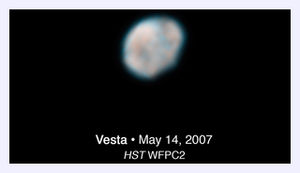
Asteroid Vesta as seen by NASA's Hubble Space Telescope.
The most prominent asteroid in the sky is currently yours for the perusing with binoculars -- and perhaps even the naked eye.
Tomorrow night, Wednesday, Feb. 17, Vesta, the second most massive
object in the asteroid belt, reaches what astronomers like to call
"opposition." An asteroid (or planet or comet) is said to be "in
opposition" when it is opposite to the sun as seen from Earth. In other
words, if you were to stand outside with the sun directly above you at
high noon, Vesta would be directly below your feet some 211,980,000
kilometers (131,700,000 miles) away. With Vesta at opposition, the
asteroid is at its closest point to Earth in its orbit.
Wednesday night, the asteroid is expected to shine at
magnitude 6.1. That brightness should make it visible to interested
parties brandishing telescopes or binoculars, and even those blessed
with excellent vision and little or no light pollution or clouds in
their vicinity. Vesta will be visible in the eastern sky in the
constellation Leo.
What makes this space rock so prominent these days?
Along with its relative proximity at this point, a full half of the
asteroid is being bathed by sunlight when seen from Earth, making it
appear brighter. Another attribute working in the observer's favor is
that Vesta has a unique surface material that is not as dark as most
main belt asteroids - allowing more of the sun's rays to reflect off
its surface.
If spotting Vesta in the night sky has whetted your appetite
for mega-rocks, all we can say is, stay tuned. NASA's Dawn spacecraft,
currently motoring its way through the asteroid belt, will begin its
exploration of Vesta in the summer of 2011.
For more information about Dawn, visit here.
Shetland Islands: Auroras and a fireball
Wed, 17 Feb 2010 17:38 EST
SpaceWeather
This week, the brightest auroras of the year have been surging around
the Arctic Circle. Never one to waste a photo-op, English
astrophotographer Pete Lawrence boarded a "Northern Lights flight" on
Feb. 15th, and this is what he saw 37,000 ft over the Shetland Islands:
"The display was awesome and completely occupied the view, illuminating the fuselage and clouds below us in an eerie green light,"
says Lawrence. "At one point, a brilliant fireball streaked down
towards the horizon. If you're wondering why there are two fireball
trails, the main one was so bright that it left a noticeable reflection
in the plane window. What a night!"
What a night, indeed. It could be just the first of many. The
opening months of 2010 have brought a sharp increase in solar activity
and a concomitant brightening of the aurora borealis. NOAA forecasters
estimate a 25% - 30% chance of more polar geomagnetic activity in the
next 48 hours. A tip for flyers: Grab that window seat.
Brian Vike
The Vike Factor (Into the Paranormal)
Thu, 18 Feb 2010 10:50 EST
Posted: February 16, 2010
Date: February 14, 2010
Time: 6:43 p.m.
Location of Sighting: Costa Mesa, CA.
Number of witnesses: 2
Number of Objects: 1
Shape of Objects: Round.
Full Description of Event/Sighting: While
traveling south on Newport Blvd. at 18th Street in Costa Mesa,
California, we saw straight ahead a bright white circular object
rapidly fall from about 30 degrees above the horizon to a point
approximately 3.8 degrees to the west on the horizon. The fall lasted
approximately one second.
The path was an arc, somewhat as one would expect a
falling meteor to take. The light suddenly appeared and stayed
consistently bright until it reached the horizon. I believe it was far
enough away to have fallen into the Pacific ocean which was at least a
mile away. The diameter of the circle was approximately 0.12 degrees.
The round appearance in the dark was as if an airplane landing light
were aimed directly at us. There was no sound.
Comment: This is similar to the sighting by another person on the same date in close proximity of time.
US: Blue-green object falling from the sky over Gardena, California
Brian Vike
The Vike Factor (Into the Paranormal)
Fri, 19 Feb 2010 11:16 EST
Posted: February 18, 2010
Date: February 14, 2010
Time: 11:00 a.m.
Hi, I live no where near you at all, I'm actually from England. But on
the 14th February 2010, at 11:00am, I seen a huge ball of fire, it was
in day light though. I first thought it was a helicopter on fire
falling from the sky, which left a white trail where it fell. Then it
just disappeared and then a small star-like object fell from the sky.
Then as each one faded another would appear, about 4 all together. I've
Googled it, but nobody has reported anything where I live. Did you find
out anything?
Bavaria, Southern Germany - A night shift worker in west Augsburg,
observed an object which might have been a meteorite fall from the sky
at 3:04 A.M. local time (CET) and burn itself out before it hit the
ground. The appearance, angle and velocity of the phenomenon rule out
the possibility that the flaming object could have been man-made
leaving out fireworks as an explanation.
The actual size of the object and its distance was not
determinable from the observation point of Katzenstadel. Nor was any
sound audible from that distance.
People who also saw this phenomenon should call the police unit at Augsburg Mitte,+49 821 323 2110.
Comment: Below is an actual eyewitness report called in shortly after 3:06 A.M.:
"Hello!!! I've just seen a bright, glowing fireball outside
the window of my porch. Because my T.V. is right in front of the
window, I could see it just as soon as it appeared. I was very
startled."
"At first I thought that it was a New Year's rocket, but those
usually fly upwards, and downwards, and they don't have a tail. It
looked like it broke apart, like a sparkling candle. Unfortunately,
there is another house 50 meters away from me, so I could only see the
fireball for about two seconds. It must have hit the ground!"
"I know how little "falling stars" look, but this one was
ENORMOUSLY larger, (maybe because it was close), I can just describe it
as a light projectile from a signal gun. It must have been really fast,
unbelievable."
"With Warm Regards from Upper Bavaria (Bayern),
"M.S."
UPDATE: Information can also be directed to Dieter Heinleinm,
dieter-heinlein@-online.at from the DLR, Feuerkugelnetz, (German Air
and Space Agency: Department "Fireballs").
CC your report to Thomas Grau of European Research Center for Fireball and Meteorites.
Unfortunately, the cameras of those agencies that would most
likely have recorded the event were offline at the time of the
incident.
Comment: According to The Polish Fireball Network, the fireball was above -10 magnitude.
Jane Sims
London Free Press
Sat, 20 Feb 2010 23:00 EST
For a few seconds tonight, the sky in south London lit up - all from a peanut-sized object hitting the atmosphere.
It was a meteor.
Members of the London chapter of the Royal Astronomical Society of
Canada confirmed what many others saw just after the supper hour.
A bright light that began as orange, then turning white sailed from the northwest towards the southeast.
One observer believed the light trailed over the sky for as long as five seconds.
Dave McCarter, the chapter president simply wished he had seen it.
"They're fairly frequent," he said. "If you're out looking up the likelihood, you're going to see some of these nice meteors.
McCarter said frequently they're seen early in the evening.
And what sailed over the city, he said, was likely no bigger
than a peanut but hit the atmosphere at 15 to 20 kilometres per second.
"That causes the atmosphere to get real bright, real fast for a few seconds," he said.
When the meteor crashes into the atmosphere, it ionizes the air, he said. And "it's the air that's giving off all that light."
Comment: Interesting
that at other times in other countries the national press trivialises
sightings of fireballs in the sky by reassuring readers just how rare
they are, but here the emphasis has flipped to place the sighting
within the context of them happening "all the time!"
Nothing to see here folks, it's just another space rock (which we'll
guesstimate was the size of a peanut to reinforce the notion that it
was utterly insignificant) that turned night into day over yet another
major population center!
My meteorcamera captured this awesome fireball in Finland Rajamäki.
Camera is pointed to at NW and has approx 85 degrees wide field of
wiew.
.
Richard Gray,
Telegraph.co.uk
Sat, 20 Feb 2010 12:17 EST

Siding Spring: Among the first images to be beamed back were the red streak of a comet, called Siding Spring
A
space telescope sent into orbit around the Earth to map previously
unseen parts of the heavens has sent back its first images, including
one of a deep space comet racing through our solar system.
The Widefield Infrared Survey Explorer (WISE) began its scan of the
entire sky on January 14 in a bid to help astronomers spot previously
unseen objects both inside and outside our solar system.
The 9ft long space telescope is using infrared light, which
cannot be seen with the human eye, to build up a map of the entire sky
visible from its orbit 300 miles above the Earth.
Among the first images to be beamed back were the red streak of a
comet, called Siding Spring, as it races through our solar system,
leaving a 10 million mile long tail of glowing dust in its wake.
The giant lump of ice and dust originated from a frozen cloud
of comets surrounding our solar system called the Oort Cloud, but at
some point was knocked out of its orbit and was sent careering closer
to the sun.
In December last year Siding Spring passed 116 million
miles from the Earth, just one and a quarter times the distance of the
Earth from the sun.
It's glowing red tail is caused by light from the sun causing it to shed ice and dust as it travels through the solar system.
During its six month mission, WISE is expected to find dozens
of previously unseen comets, including those that may come close to the
Earth's own orbit around the sun. WISE has already discovered one
near-Earth asteroid and a new comet.

Andromeda
Galaxy: The massive Andromeda galaxy, which is also known as Messier
31, is about 2.5 million light years away and bigger than the Milky Way
Another
picture gives a colourful glimpse of the closest large galaxy
neighbouring our own. The massive Andromeda galaxy, which is also known
as Messier 31, is about 2.5 million light years away and bigger than
the Milky Way.
The galaxy's spiralling arms can be seen made up of blue
mature stars while yellow and red dust glows as it is heated by newborn
stars.
During its mission, WISE is expected to capture images of all
50 galaxies that surround our own and make up the so called Local Group
of galaxies.
In another image, a churning yellow mass of gas and dust gives
a new insight into a star forming factory around 20,000 light years
away from our solar system.
"All these pictures tell a story about our dusty origins and
destiny," said Peter Eisenhardt, the WISE project scientist at NASA's
Jet Propulsion Laboratory in Pasadena, California.
"WISE sees dusty comets and rocky asteroids tracing the
formation and evolution of our solar system. We can map thousands of
forming and dying solar systems across our entire galaxy.
"We can see patterns of star formation across other galaxies,
and waves of star-bursting galaxies in clusters millions of light years
away."
The WISE mission will scan the sky one-and-a-half times by
October, taking nearly 1,500,000 pictures. By that time the frozen
coolant needed to chill its instruments will be depleted and the
telescope is expected to slowly die.
"WISE has worked superbly," said Ed Weiler, associate
administrator of the Science Mission Directorate at NASA Headquarters
in Washington.
"These first images are proving the spacecraft's secondary
mission of helping to track asteroids, comets and other stellar objects
will be just as critically important as its primary mission of
surveying the entire sky in infrared."
Timo Leponiemi
YLE.fi Translation: Sott.net
Tue, 23 Feb 2010 11:10 EST
The
bright shooting star that was seen in the sky of southern Finland on
Friday 19 February at 00.05 AM could have dropped a 100 gram meteorite
in Kärkölä, in Southern-Häme.
The fireball that was seen shortly after midnight in the sky over
southern Finland could have dropped a spacerock along the
Riihimäki-Lahti train track. The fireball was observed in Kuru and was
captured by six meteorite-observing cameras.
The bright part of the trail in the sky has been determined to
be around 100 meters in length based on the video footage of the
fireball.
The mathematician and meteor researcher Esko Lyytinen
estimates that the fireball dropped a rather small meteorite, weighing
maybe ca 100 grams.
The probable crash site is somewhere in the region of Lappila, near the train track leading from Riihimäki to Lahti.
It's unlikely the spacerock will be found in the snowy terrain.
Only 13 meteorites have been found in Finland so far. The most recent
incident is the meteorite that fell through a fisherman's hut in Haverö
almost 40 years ago in 1971.
Brian Vike
The Vike Factor (Into the Paranormal)
Tue, 23 Feb 2010 14:38 EST
Posted: February 21, 2010
Date: February 20, 2010
Time: 10:30 p.m.
Location of Sighting: Mier Park Stoke On Trent
Number of witnesses: 4
Number of Objects: 2
Shape of Objects: Round and orange.
Full Description of Event/Sighting: We
was watching TV when all of a sudden my wife looked out the window and
said, what's that in the sky. We all started looking out the window and
first we saw one orange fiery ball going at a steady speed, but it was
quicker than a plane. Then another one appeared and followed it at the
same speed. I quickly grabbed my camera and went upstairs and took two
photos, which I have got for proof.
At first we thought they were planes, but when have
you ever seen a round plane. Then we thought they could of been hot air
balloons, but air balloons can't travel at the speed of which these
orange balls were traveling at. We also thought they could off been
shooting stars, but these where going in a straight horizontal line and
then they vanished going upwards towards the sky.
People looking up at the sky early this morning might have seen a
strange sight - a fireball, shooting across the sky, which Manitoba
Planetarium astronomer Scott Young said might have left debris behind.
"It looks like a fireworks display," said Young. "One report said it was greenish in color."
There have been numerous reports of people seeing a ball of
fire streak across the sky around 6:30 am. near the Birds Hill Park
area, north of Winnipeg.
The fireball is known to astronomers as a bolide, a large
meteor or shooting star. Young said this happens when a grain of space
debris comes in contact with the atmosphere, where the friction heats
up the meteor, making it look like a ball of fire. He said based on
reports, this bolide was probably the size of a baseball or cabbage.
It's large size means it has more of a chance of leaving a meteorite
behind.
"Smaller versions of this happen every day in the world,"
Young said. "But it's pretty rare for someone to see something as big
as this."
Myron Witnicki witnessed the fireball when he was driving into
work from Birds Hill to St. Andrews down Provincial Road 202. He said
he saw something in the sky at around 6:50 a.m. At first he thought it
was a plane, but then realized it might be some kind of shooting star.
"It streaked left to right like a huge ball in the sky," he said.
He said the object was about the size of a toonie with a tail the third
of the length of his windshield. The orangey-red ball lasted for about
two to three seconds, travelling from West to East before it fizzled
out, he said.
"It looked like something out of a disaster movie," said Witnicki.
The fireball was about 30 kilometres up in the air if people
could see it burning, said Young, and went eastward towards the
horizon, probably far away from the Winnipeg area.
Young said they are looking for more eyewitness reports or anyone who thinks they may have found debris from the bolide.
"They're very dark rocks and usually very heavy for their size," he said.
He also mentioned that the meteorite would probably be very
magnetic and smooth with no bubbles or crystals. Anyone with
information is asked to contact Scott Young at the Manitoba
Planetarium.
Anne M. Stark
Lawrence Livermore National Laboratory
Thu, 25 Feb 2010 18:47 EST
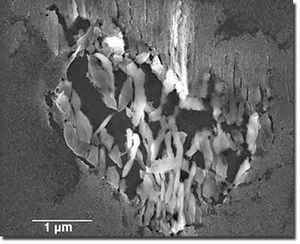
Secondary electron image of the Coki section analyzed in this study showing mineral shards surrounded by compressed aerogel.
Livermore,
California - Though comets are thought to be some of the oldest, most
primitive bodies in the solar system, new research on comet Wild 2
indicates that inner solar system material was transported to the
comet-forming region at least 1.7 million years after the formation of
the oldest solar system solids.
The research by Lawrence Livermore National Laboratory
scientists and colleagues provides the first constraint on the age of
cometary material from a known comet. The findings are published in the
Feb. 25 edition of Science Express.
The NASA Stardust mission to comet Wild 2, which launched in 1999, was
designed around the premise that comets preserve pristine remnants of
materials that helped form the solar system. In 2006, Stardust returned
with the first samples from a comet.
Though the mission was expected to provide a unique
glimpse into the early solar system by returning a mix of solar system
condensates, amorphous grains from the interstellar medium and true
stardust (crystalline grains originating in distant stars), the initial
results painted a different picture. Instead, the comet materials
consisted of high-temperature materials including calcium-aluminum rich
inclusions (CAIs), the oldest objects formed in the solar nebula. These
objects form in the inner regions of the solar nebula and are common in
meteorites.
The presence of CAIs in comet Wild 2 indicates that the
formation of the solar system included mixing over radial distances
much greater than has been recognized by scientists in the past.

Corresponding false color mineral map overlaid on a montage of brightfield Transmission Electron Microscope (TEM) images.
"The
inner solar system material in Wild 2 underscores the importance of
radial transport of material over large distances in the early solar
nebula," said lead author Jennifer Matzel of the Laboratory's Institute
of Geophysics and Planetary Science and the Glenn T. Seaborg Institute.
"These findings also raise key questions regarding the timescale of the
formation of comets and the relationship between Wild 2 and other
primitive solar nebula objects." Analysis showed that the inner solar
system materials formed 1.7 million years after the onset of CAI
formation.
Other LLNL team members include Hope Ishii, Ian Hutcheon, John
Bradley, Peter Weber and Nick Teslich. Colleagues include scientists
from the University of Washington, University of California, Los
Angeles and the Smithsonian Institution.
Founded in 1952, Lawrence Livermore National Laboratory
(www.llnl.gov) is a national security laboratory that develops science
and engineering technology and provides innovative solutions to our
nation's most important challenges. Lawrence Livermore National
Laboratory is managed by Lawrence Livermore National Security, LLC for
the U.S. Department of Energy's National Nuclear Security
Administration.
Sandi Cauley
WVTR.com
Fri, 26 Feb 2010 20:42 EST
Richmond Metro - Did you hear it - A loud boom, a thud or something sounding like an explosion?
We've received several messages on our CBS 6 Facebook fan page. Reports
from people hearing a loud noise between 8:30 a.m. and 9:00 a.m. We
tried to pinpoint the exact location, but the reports were widespread.
We got reports from south east Powhatan to Midlothian, Chester, Hanover
County and even Nottoway County.
We contacted Virginia Tech's Seismological Society who said it was not an earthquake, but they did record an "acoustic" boom.
CBS 6 also made calls to Dominion Virginia Power to see if a
transformer or other power equipment had exploded, but a DOM spokesman
said they had very few if any outages at that time or even later in the
day.
We are waiting on calls back to find out if it could have been a sonic boom or some type of military training.
"You
should have seen it!" shouted a young boy in the crowd. Pointing to a
large black stallion drinking from a trough, he added, "It was as big
as that ther horse over ther'."
But, we don't need to rely on the word of a child to know that
this "rock from another planet" was gigantic. There were dozens who saw
it fall and thousands more that touched it.
In January, 1888, several Florida residents witnessed a "large
green streak" falling through the sky. Known as a shooting star, the
meteorite was visible throughout the entire southeast. Trying to
project its final location and landing zone, each witness pointed to a
field nearby where they were standing. Whether they lived in Key West,
Miami, Palatka or Jacksonville, they would motion in a particular
direction and then say, "Its got to be right over there."
It turns out that the monstrous meteorite (the envy of the
world) fell to the earth in Middleburg, Florida. It was late in the
evening when several passersby witnessed its arrival then heard a
tremendous "thud." Every house in the town shook.
Running
to farmer J.W. Barber's newly cultivated land, they approached a
smoking hole and right there in front of them was this catch of a rock.
Farmer Barber rode up on his horse in his bedclothes and inquired, "What the hell is all the commotion on my land about?"
"Take a look for yerself, knucklehead," one man shouted.
Farmer Barber approached the smoldering hole and said, "Just which one of yous dug this hole and burned some wood."
Shaking his gun like an Indian spear, he said, "I'll use this
on ya. I've got rock salt loaded to the top. Doya think I'm crazy?"
Pointing at the large steaming rock, one man shouted, "J.W., have ya ever seen a rock on fire?"
Farmer Barber was now close enough to see the large rock. It
had a whiteish appearance and looked similar to a lump of coal just
after it was pulled from the fire.
"Now just where did that thing come from?" he inquired. He
looked around at everyone, scanning their faces for some type of
reaction.
An older boy, unwilling to be shot in the behind said, "Put down that gun and we'll tell ya.'
The farmer obliged and sat the gun on the ground. Lifting his head back up he noticed that everyone was looking to the sky.
Pointing upward, the boy said, "This is going to sound stupid fer sure, but it fell from up der."
The farmer, now with a look of disgust shouted, "Now I've just
about had enough." He reached down toward the gun when a big man with a
badge stepped on its barrel. It was the local sheriff. He said, "They
told you the truth J.W., that thing fell from the sky."
Scratching his head in disbelief, farmer Barber said, "Oh my goodness gracious. Now I've seen dang near everything."
The next morning, farmer Barber was the town's celebrity. Pointing to the
sky like some kind of expert, he could heard saying, "The thing
just dropped from the sky and don't let me hear ya say ya don't believe
it." He had taken time to build a wooden fence around the hole in order
to preserve his find.
Observing a young boy sticking his head through the fence,
farmer Barber shouted, "Boy, don't get too close now," People were
standing ten deep just to get a peek at his "stone from the heavens."
A neighbor said, "J.W. you are so lucky. That's damn near the largest stone from the sky that anyone has ever found.
Suddenly, a man they termed a "city boy" stepped up and said,
"You could be right. There were a couple of meteorites that fell in
Spain that might be larger but this one is truly a keeper and may be in
the record books."
The
timing could not have been better to have a natural amusement enter the
earth's atmosphere. It was just weeks before Florida's Subtropical
Exposition and this was a unique item. Exposition organizers approached
the farmer for permission and after guarantees that his land would be
returned to its original state; he accepted their offer to remove the
iron stone and display it in Jacksonville.
It was not clear whether the farmer requested the meteorites return after its display.
Block and tackle assisted in its removal and placement on a
washboard wagon pulled by several horses. The trip from Middleburg to
Jacksonville,
Florida, took nearly two full days.
For nearly three years, the 200 pound magnificent piece was displayed in
its special cradle. It was touched, sat on, kissed, prayed to and even
painted. It was stroked by the President of the United States, the First
Lady, the Governor, Mayors of several cities and many other dignitaries.
There were those who brought tools to remove a piece for posterity but none were successful. They left empty-handed.
Sometime during its display, Dr. Hahn, meteorite expert from
Germany, traveled to Jacksonville to photograph and examine the
meteorite. He exclaimed that he had proof of fossils inside the giant
ore and wrote a paper outlining his find. Years later, his claims were
discredited.
Sadly, after Jacksonville's Subtropical Exposition, the meteor
was removed and never seen again. There are several newspaper articles
published during this time period throughout the world which suggest a
group of thieves would acquire meteors for its mineral deposits. They
would melt the rock which would separate each individual metal and sell
the results to the highest bidder.
Whether this theft occurred or not the Middleburg Meteor has never been seen again.
Jonathon Howe
Manawatu Standard
Fri, 26 Feb 2010 23:26 EST
A mysterious explosion near the Manawatu River has baffled residents and authorities in Palmerston North.
Hokowhitu residents around Heatley Ave and Hind Place reported a loud
bang, orange light and smoke near the river about 10.30pm, on
Wednesday.
Heatley Ave woman Helen Hughes was in her office, which faces the river, when she heard the explosion.
"It was extraordinarily loud because everybody thought it was in their backyard ... I thought it had shaken the house."
"I saw the light that accompanied the noise and it was orange and at sky level."
Mrs Hughes said a lot of people came outside to investigate.
"One said they saw smoke in the direction of the river. Another said
they saw a blue light in the direction of Crewe Cres."
A possible cause was someone blowing up a gas canister but a
scan of the riverbank by a Manawatu Standard reporter and photographer
revealed no scorch marks or debris.
Another Heatley Ave resident who heard the bang was Tatyana Pinkney.
"It was really weird, and very loud ... it sounded like a gunshot."
It was a still night so Mrs Pinkney listened out for footsteps or talking after the bang, but heard nothing.
Authorities have been unable to explain what caused the explosion.
Police investigated after receiving a call from a Hind Place resident, but did not discover the origin of the blast.
Metservice spokesman Bob McDavitt said it could not have been a
lightning strike because the nearest thunderstorm was in Waikato.
Palmerston North Airport chief executive Garry Goodman said he was unaware of any activity in the air space.
Linton Army Base spokesman Paul Stein said there was no live firing in the area at the time.
HAVE YOUR SAY
Do you know what caused the explosion? Write to the editor at PO
Box 3, Palmerston North, or editor@msl.co.nz (include names and
addresses), or text 0274981242.
Residents across the Metro Richmond area and beyond are reporting hearing a loud explosion early Friday morning.
The question is: what was it?
8News has been contacted by dozens of citizens who experienced the
phenomena, with most saying the heard and felt it in the Midlothian
area of Chesterfield County, between 8:30 and 9 a.m. However, some have
reported hearing the "boom" in Mechanicsville, Colonial Heights,
Blackstone and even as far away as Nottoway County.
The noise has been described as an explosion, a deep rumbling, a transformer blowing or even thunder.
8News is checking with a variety of organizations, including the
Virginia Tech Seismological Observatory, trying to track down the
source of the noise.
If you heard it, email us, at news@wric.com.
For the latest, watch 8News at 5 and 6.
Copyright 2010 by Young Broadcasting, Inc.
Jean Tate
Universe Today
Sat, 27 Feb 2010 15:17 EST
No,
it's not the Universe Puzzle No. 3; rather, it's an intriguing result
from recent work into the strange shapes and composition of small
asteroids.
Images sent back from space missions suggest that smaller
asteroids are not pristine chunks of rock, but are instead covered in
rubble that ranges in size from meter-sized boulders to flour-like
dust. Indeed some asteroids appear to be up to 50% empty space,
suggesting that they could be collections of rubble with no solid core.
But how do these asteroids form and evolve? And if we ever
have to deflect one, to avoid the fate of the dinosaurs, how to do so
without breaking it up, and making the danger far greater?
Johannes Diderik van der Waals (1837-1923), with a little help
from Daniel Scheeres, Michael Swift, and colleagues, to the rescue.
Asteroids
tend to spin rapidly on their axes - and gravity at the surface of
smaller bodies can be one thousandth or even one millionth of that on
Earth. As a result scientists are left wondering how the rubble clings
on to the surface. "The few images that we have of asteroid surfaces
are a challenge to understand using traditional geophysics," University
of Colorado's Scheeres explained.
To get to the bottom of this mystery, the team - Daniel
Scheeres, colleagues at the University of Colorado, and Michael Swift
at the University of Nottingham - made a thorough study of the relevant
forces involved in binding rubble to an asteroid. The formation of
small bodies in space involves gravity and cohesion - the latter being
the attraction between molecules at the surface of materials. While
gravity is well understood, the nature of the cohesive forces at work
in the rubble and their relative strengths is much less well known.
The team assumed that the cohesive forces between grains are
similar to that found in "cohesive powders" - which include bread flour
- because such powders resemble what has been seen on asteroid
surfaces. To gauge the significance of these forces, the team
considered their strength relative to the gravitational forces present
on a small asteroid where gravity at the surface is about one millionth
that on Earth. The team found that gravity is an ineffective binding
force for rocks observed on smaller asteroids. Electrostatic attraction
was also negligible, other than where a portion of the asteroid this is
illuminated by the Sun comes into contact with a dark portion.
Fast backward to the mid-19th century, a time when the
existence of molecules was controversial, and inter-molecular forces
pure science fiction (except, of course, that there was no such thing
then). Van der Waals' doctoral thesis provided a powerful explanation
for the transition between gaseous and liquid phases, in terms of weak
forces between the constituent molecules, which he assumed have a
finite size (more than half a century was to pass before these forces
were understood, quantitatively, in terms of quantum mechanics and
atomic theory).
Van der Waals forces - weak electrostatic attractions between
adjacent atoms or molecules that arise from fluctuations in the
positions of their electrons - seem to do the trick for particles that
are less than about one meter in size. The size of the van der Waals
force is proportional to the contact surface area of a particle -
unlike gravity, which is proportional to the mass (and therefore
volume) of the particle. As a result, the relative strength of van der
Waals compared with gravity increases as the particle gets smaller.
This could explain, for example, recent observations by
Scheeres and colleagues that small asteroids are covered in fine dust -
material that some scientists thought would be driven away by solar
radiation. The research can also have implications on how asteroids
respond to the "YORP effect" - the increase of the angular velocity of
small asteroids by the absorption of solar radiation. As the bodies
spin faster, this recent work suggests that they would expel larger
rocks while retaining smaller ones. If such an asteroid were a
collection of rubble, the result could be an aggregate of smaller
particles held together by van der Waals forces.
Asteroid expert Keith Holsapple of the University of
Washington is impressed that not only has Scheeres' team estimated the
forces in play on an asteroid, it has also looked at how these vary
with asteroid and particle size. "This is a very important paper that
addresses a key issue in the mechanics of the small bodies of the solar
system and particle mechanics at low gravity," he said.
Scheeres noted that testing this theory requires a space
mission to determine the mechanical and strength properties of an
asteroid's surface. "We are developing such a proposal now," he said.
Source: Physics World. "Scaling forces to asteroid surfaces: The role of cohesion" is a preprint by Scheeres, et al. (arXiv:1002.2478), submitted for publication in Icarus.

The crash at the end of the Cretaceous period doomed important planktonic plants.
The
extraterrestrial body that slammed into Earth 65 million years ago is
best known for killing off the dinosaurs. But it also snuffed out more
than 90% of the tiny plankton species that made up the base of the food
web in the oceans. By sifting through geological records of ancient
sediments from around the globe, palaeoceanographers have culled clues
about how the impact caused so much havoc.
The researchers report in Nature Geoscience1
today that the most severe extinctions of nannoplankton happened in the
northern oceans and that the ecosystems there took 300,000 years to
recover, much longer than in the south. Given that pattern, the
researchers speculate that the direction of the impact caused
long-lasting darkness in the Northern Hemisphere and metal-poisoning in
the northern oceans.
Nannoplankton with calcium-based shells were the primary photosynthetic
producers in the oceans until 65 million years ago, at the boundary
between the Cretaceous and Palaeogene periods. But 93% of those species
went extinct - along with ammonites, large marine reptiles such as the
plesiosaurs, and all the dinosaurs. The extinctions have been linked to
the Chicxulub impact crater, which is buried beneath the Yucatán
peninsula in Mexico.
To trace the geographical distribution of the
extinctions, Timothy Bralower from Pennsylvania State University in
University Park and his colleagues examined published records that
analysed fossil nannoplankton at 17 sites spread across the globe. They
found that up to 98% of species went extinct in the northern oceans,
whereas rates in the southern ocean were lower; the most southerly site
at the time lost 73% of its nannoplankton species. "There's an
incredibly strong correlation between extinction rate and latitude,"
says Bralower.
The Southern and Indian oceans fared better in other ways as
well. Species diversity was less affected, and the normal species
assemblages returned almost immediately. But it took up to 300,000
years after the impact for species diversity to recover in the northern
oceans, according to the researchers.
Phytoplankton probably influenced the restoration of the
entire marine ecosystem, says Bralower. Their slow recovery in the
north would have impeded the resurgence of the whole northern oceanic
food web.
Other researchers have previously detected latitudinal
differences in the catastrophe. North American land plants were
particularly hard hit compared with species on southern continents.
Geological evidence suggests that the body that hit Earth was
travelling from the southeast to the northwest. That kind of collision,
along with the planet's rotation, would have thrown up more debris over
the Northern Hemisphere and blocked out the sun for an extended period.
"Suppression of photosynthesis and darkness would explain the extinctions and the diversity drop," Bralower says.
Poisoned seas
But the delayed recovery in the north was a mystery. "You'd
expect that once it got light again, they would start flourishing
again. Why would it take up to 300,000 years to come to normal
diversity in the Northern Hemisphere?" comments Bralower.
The team tested several hypotheses, such as ocean cooling and
acidification, but decided that metal poisoning is the only mechanism
that could have caused that delay. They surmise that the impact spewed
heavy metals into the sky and that these landed mostly in the northern
oceans. High concentrations of metals can be toxic to living organisms
and inhibit reproduction. And the suppression of photosynthesis in the
north would have prevented plankton from taking up the toxic metals and
clearing them out of the surface ocean.
"Until this study, you could imagine no environmental
mechanism to inhibit the recovery of plankton after light conditions
were restored. So what we've done is put numbers on how long it took
for critical parts of the food chain to recover," Bralower says. "It
was staggeringly long."
Although several geoscientists are impressed by the
latitudinal differences reported in the new paper, they are sceptical
about the metal hypothesis.
"The reality is, the ocean is one big ocean," says Steven
D'Hondt, an oceanographer at the University of Rhode Island in
Narragansett. He says the ocean would mix in a thousand years and
spread any heavy metals around. To explain the different rates of
recovery, he says, he would "poke around in evolutionary ecology to
find possible explanations".
James Zachos, a palaeoceanographer from the University of
California, Santa Cruz, agrees. "I suspect these findings might be
telling us more about the ecosystem recovery process from severe
extinction, rather than about the extinction process," he says.
Previous studies of marine molluscs have shown that widespread
lineages survived the extinction better than ones with fewer species
and more restricted ranges, according to David Jablonski, a
palaeontologist at the University of Chicago in Illinois. The mollusc
data2
suggest that extinction intensity was fairly uniform across the globe,
says Jablonski. But he adds: "If you squint your eyes a little at my
data, high southern-latitude mollusc extinction is a little milder than
elsewhere."
According to Bralower, species that lived in the high southern
latitudes were adapted to low light and high metal concentrations and
this allowed them to survive the immediate effects of the impact.
"Adaptation is a critical factor in survivorship and the effect of the
impact is built on top of that," he says.
Even if nannoplankton in the south suffered less than those in
the north, it was "still a hell of a hit", says Jablonski. "No matter
what, it was a bad time to be phytoplankton at the end of the
Cretaceous period anywhere in the world."
References
1. Jiang, S., Bralower, T. J., Patzkowsky, M. E., Kump, L. R. & Schueth, J. D. Nature Geosci. online publication doi:10.1038/ngeo775 (2010).
2. Raup, D. M. & Jablonski, D., Science 260, 971-973 (1993).
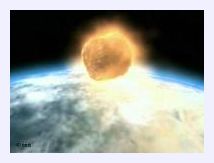
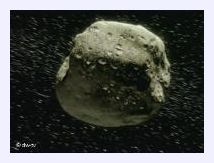

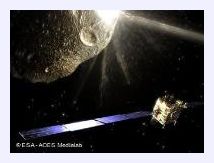
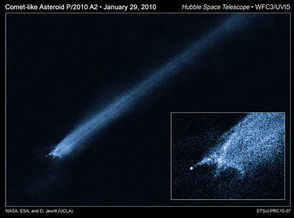
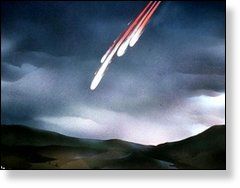
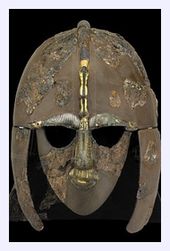
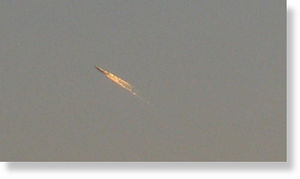
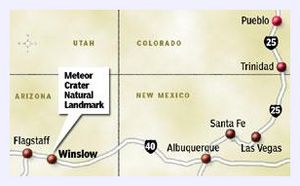

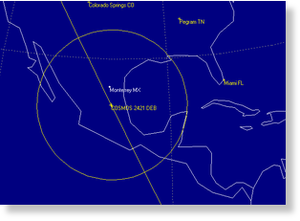
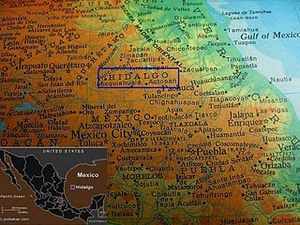
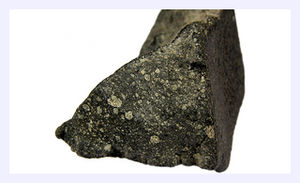
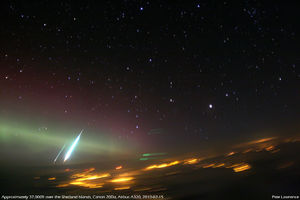
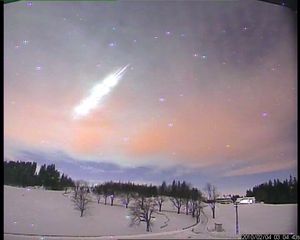
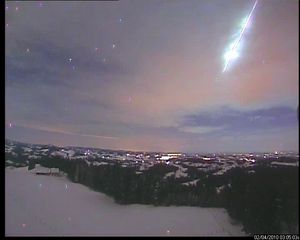
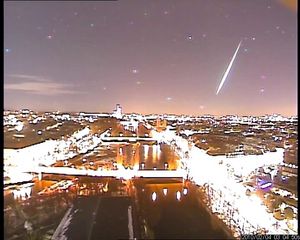
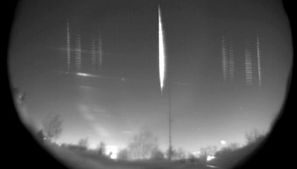
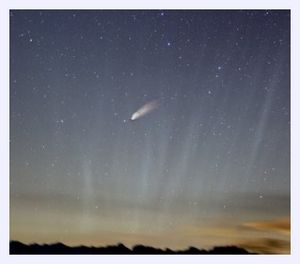
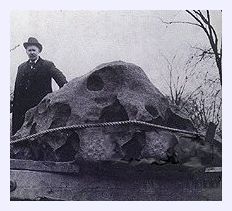

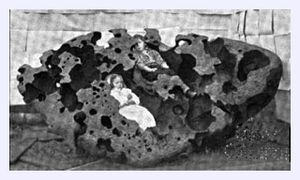
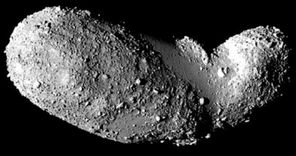
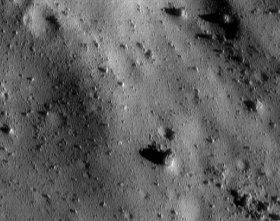
1 comment:
The book, Cycle of Cosmic Catastrophes is one of the most riveting I have ever read. Owned it four years and read it four times and now into the fifth. My veiw is we are helpless to stop these occurences and considering that 98% of all life that ever existed, is extinct; who do we think we are? Treat the universe with respect and enjoy every minute because we are only a blip on the screen of time. Don't atke life so seriously, you will never get out alive.
Post a Comment